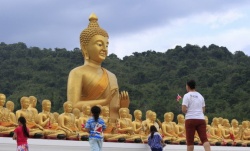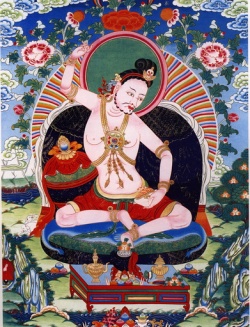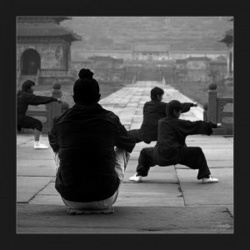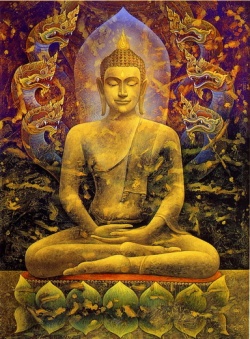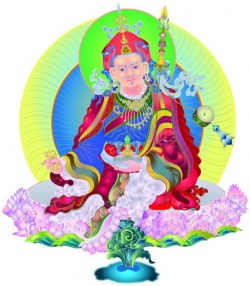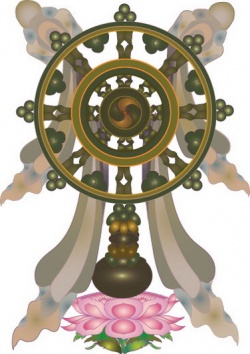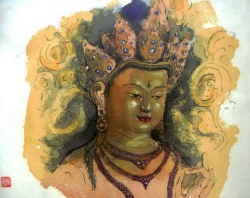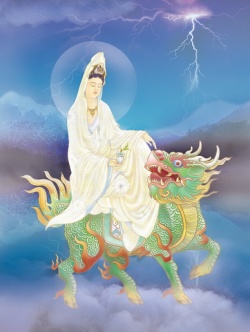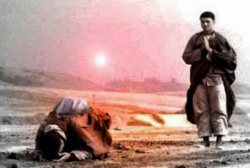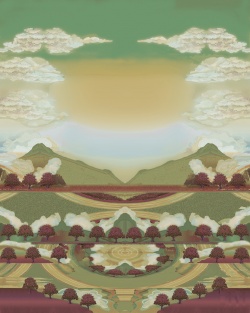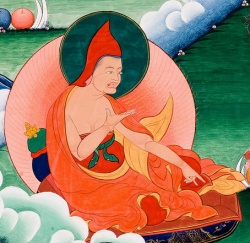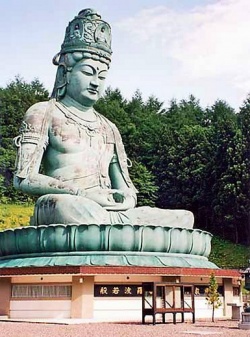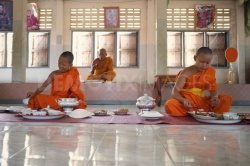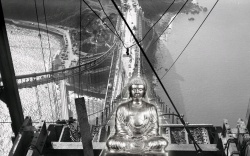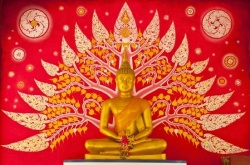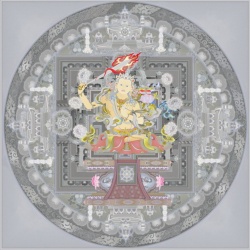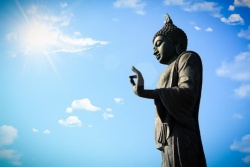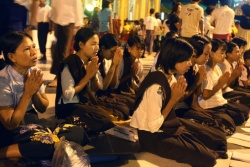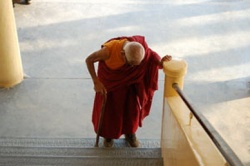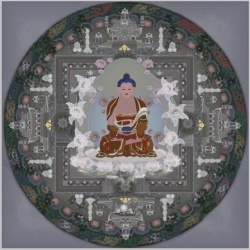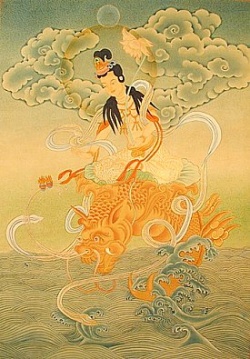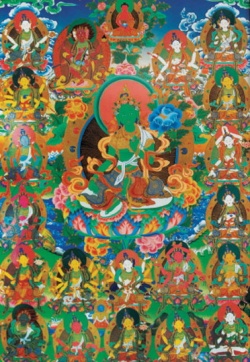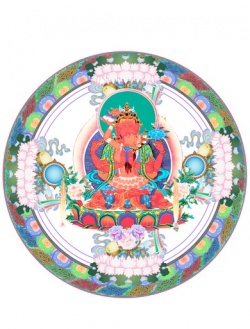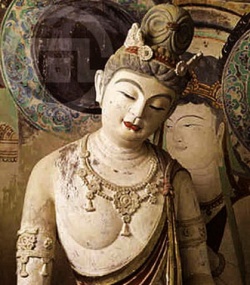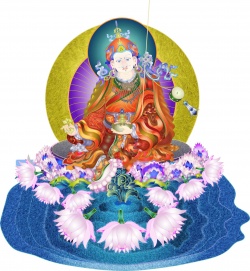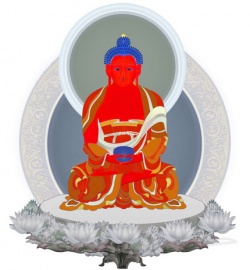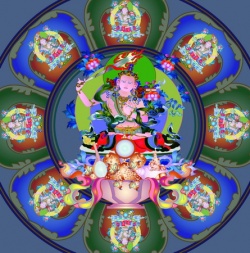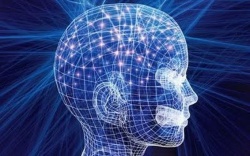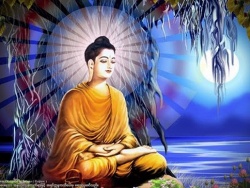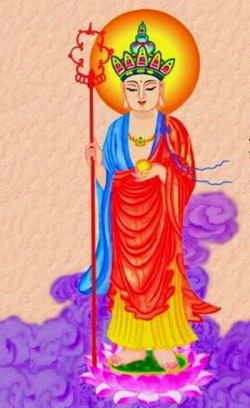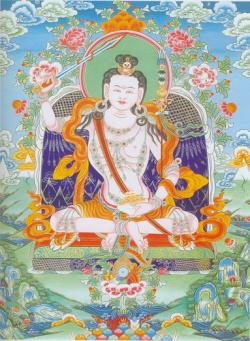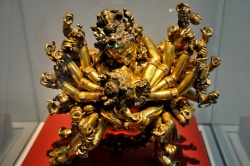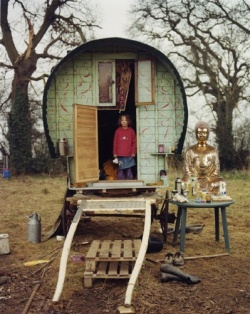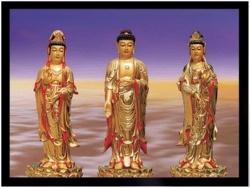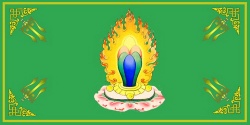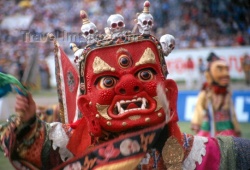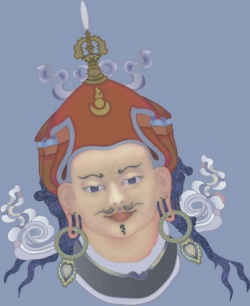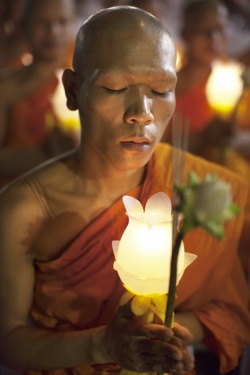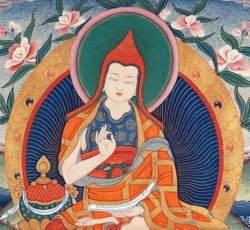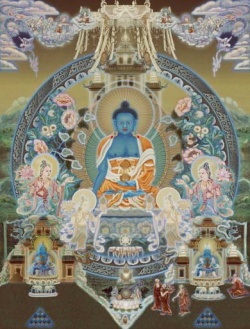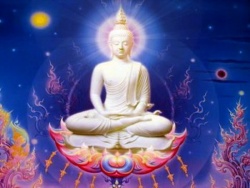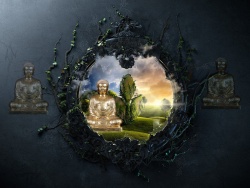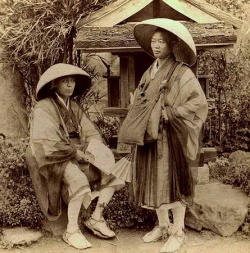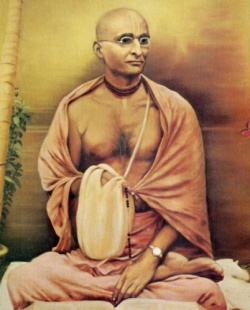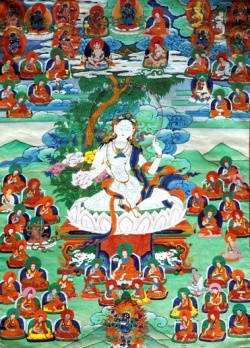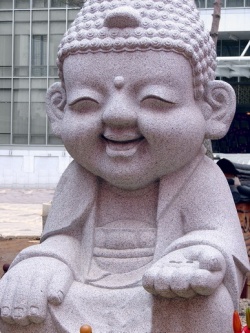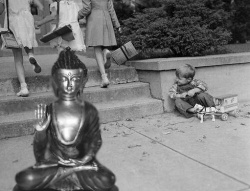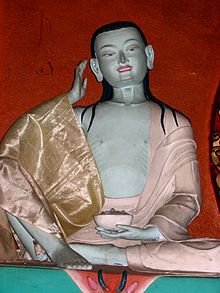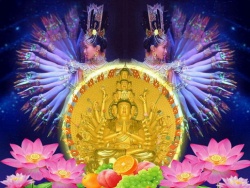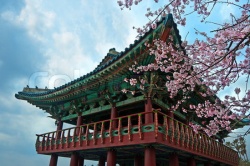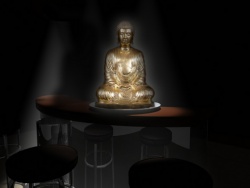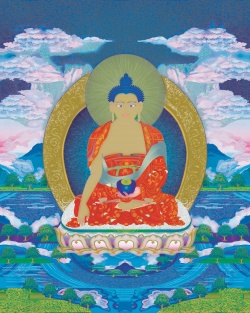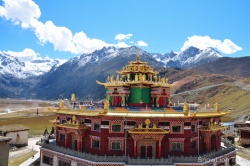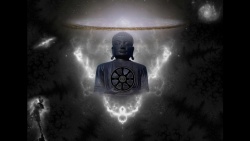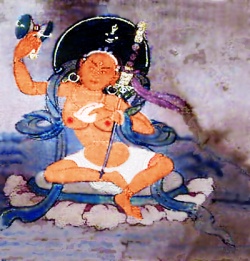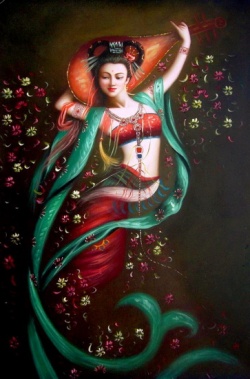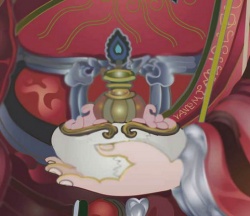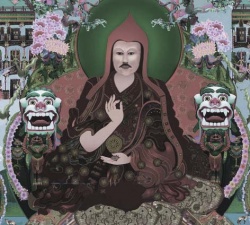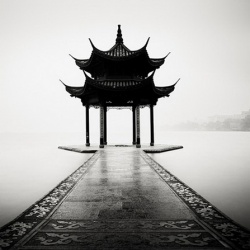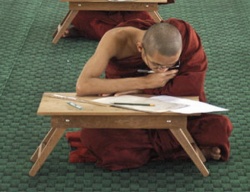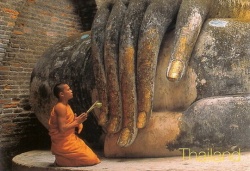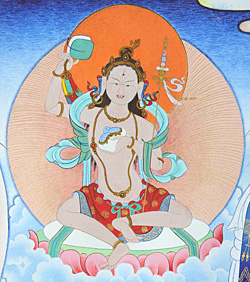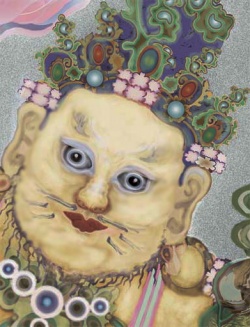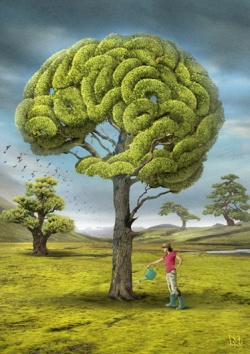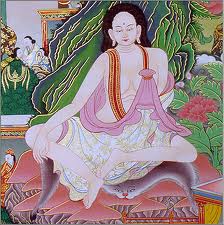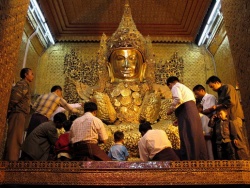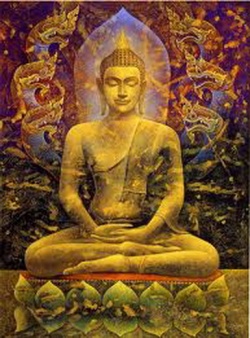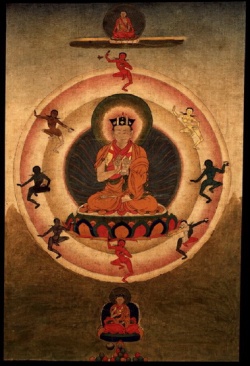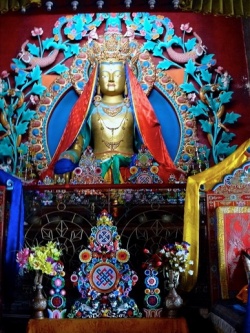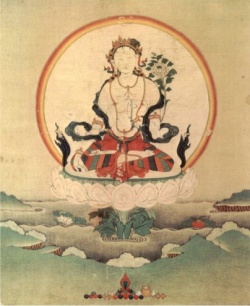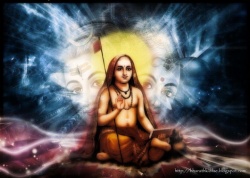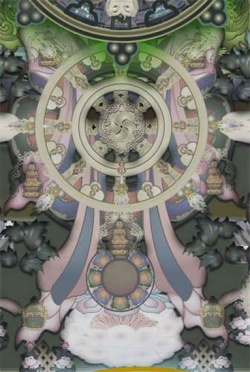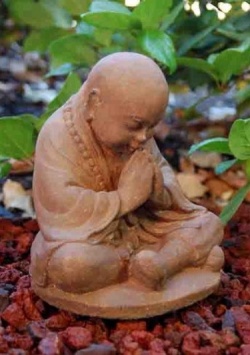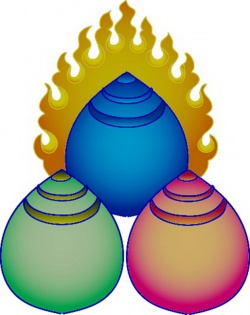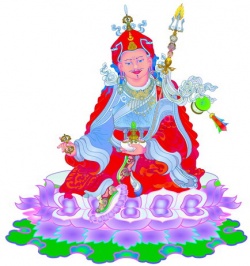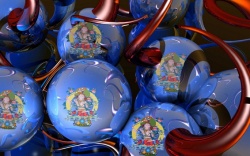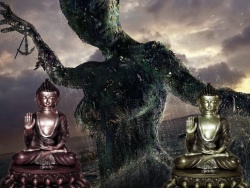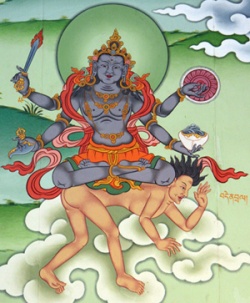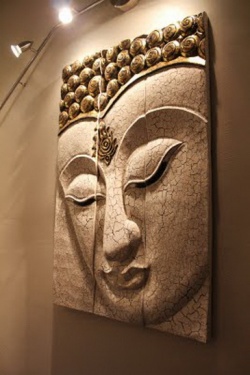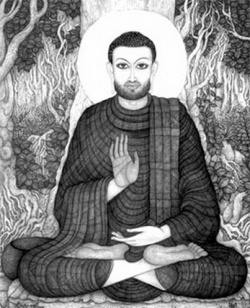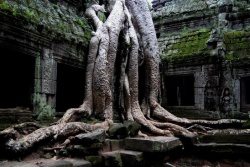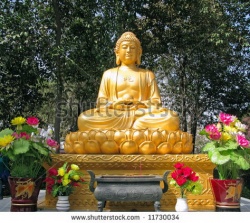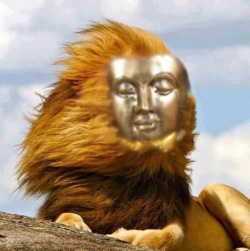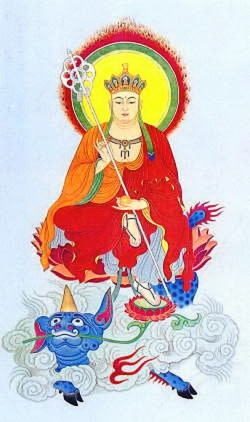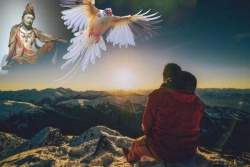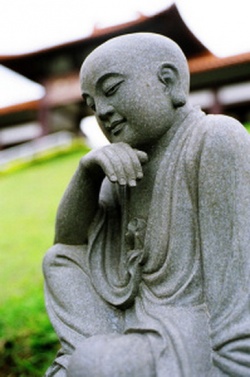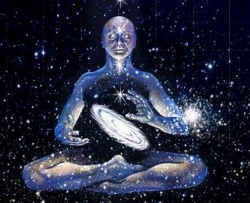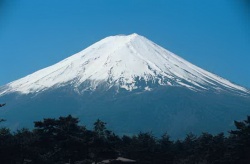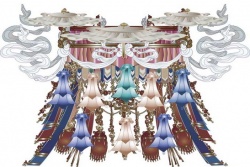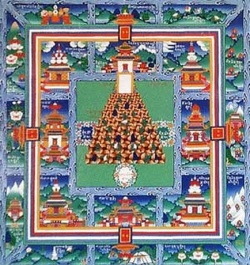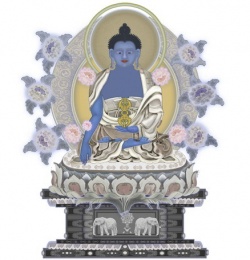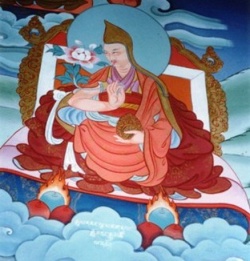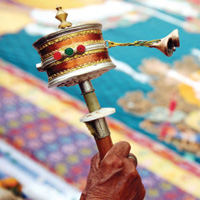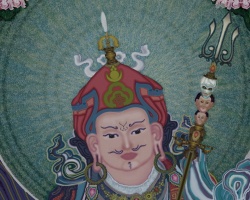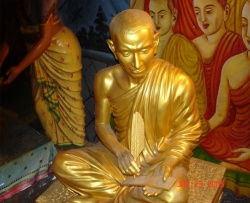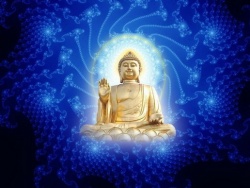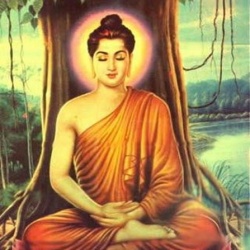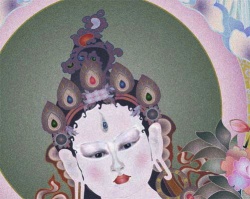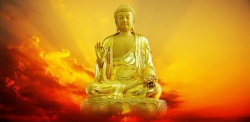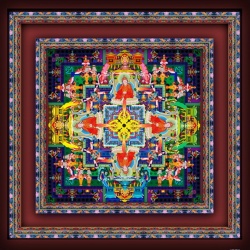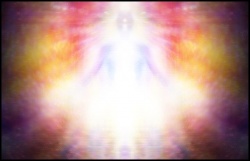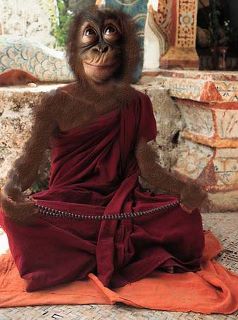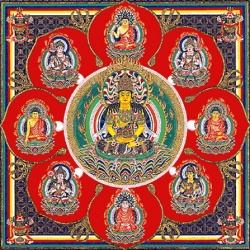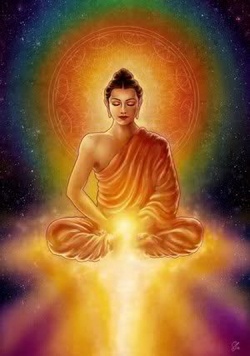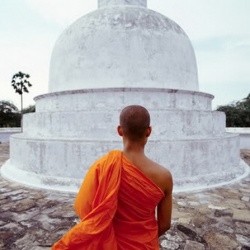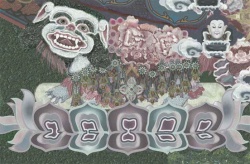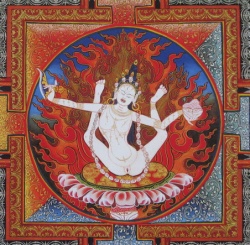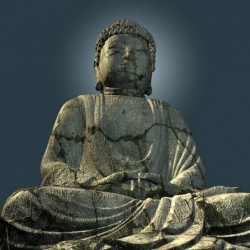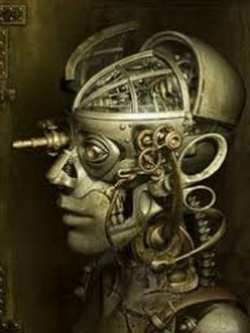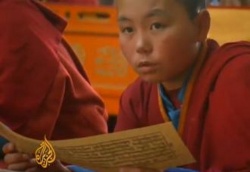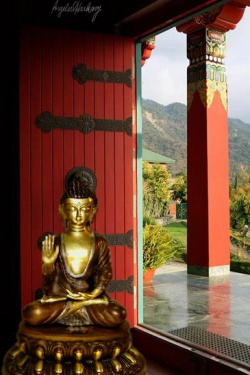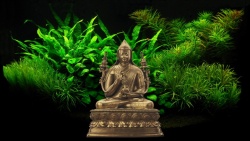The Dharma Flower Sutra seen through the Oral Transmission of Nichiren Daishōnin: The Third Chapter on Similes and Parables
The Dharma Flower Sutra
seen through the Oral Transmission of
Nichiren Daishōnin
The first important point, concerning the Chapter on Similes and Parables.
It says in the Textual Explanation of the Dharma Flower Sutra (Hokke Mongu) that a simile is a concept that involves the comparison of one thing with another as an illustration and that a parable has the implication of instruction and getting people to understand. In the sense that since the universal compassion of the Tathāgata is unremitting and perpetual and his dexterous and discerning wisdom is without bounds, so that when the trees rustle and move in different directions, this is used as an instance to teach people about the wind, as is holding up a folding fan in order to make people aware of the moon.
The Oral Transmission on the Meaning of the Dharma Flower Sutra (Ongi Kuden) says that the universal compassion of the Tathāgata is like the loving-kindness and aid that a mother bestows on her child. Nowadays this universal compassion is the role of Nichiren. Shōan, in his Annotations on the Sutra on the Buddha’s Extinction into Nirvana, stated, “Somebody who rids people of evil is acting as their parent.”
The dexterous and discerning wisdom of the Tathāgata is Nam Myōhō Renge Kyō, which is the establishment of our lives on and devoting them to the time and place of the interdependence of cause, concomitancy and effect that constitutes the totality of existence.
Since the teachings and the texts that are recited by all other schools are devoid of the entirety of existence, their doctrines cannot lead to the attainment of the path of Buddhahood. Also, the expression “the dexterous and discerning wisdom of the Tathāgata” indicates his skilfulness in the practice of difficult questions and answers. After all, when Shākyamuni was in the world, he recounted these various similes and parables for the benefit of the people with average and lesser propensities. Also, you should know that these similes and parables were for the time for when Shākyamuni had passed over to the extinction of nirvana (metsugo) and that his Dharma had come to its end (mappō).
The rustling and movement of the trees represent our troublesome worries (bonnō, klesha) and the blowing of the wind is the teaching that our troublesome worries (bonnō, klesha), are not separate from enlightenment, since these psychological dimensions are situated in our heads. The folding fan that is held up in the air symbolizes the obtrusive processes of living and dying. The moon is a representation of nirvana, which is said to be indestructible, unmanifested, and non-substantial, as well as being the state of enlightenment attained by Shākyamuni.
Nowadays when Nichiren and those that follow him reverently recite Nam Myōhō Renge Kyō, they are getting into the cart of the great white bullock [mentioned later in this chapter) and arrive directly at the place of the attainment of the path of enlightenment.
In the Annotations on the Textual Explanation of the Dharma Flower Sutra, it says, “The trees, the folding fan, and the moon are simply visualisations of the universal truths of the all-inclusive doctrine.” The same commentary states, “How could it be that the explanations of the real aspect of all dharmas could be concealed for a time and then for a time be revealed all over again? It is rather like the long blowing wind that never really dies down, or the moon that is in the sky forever.”
You should take these explanations into consideration. “Concealment” refers to death, and “revealing” represents life. The long blowing wind stands for our breathing, and the round full moon in the sky depicts the immaculate quality of the immeasurability of mind itself and our individual minds as well.
Living and dying, according to the Dharma Flower Sutra (Hokke-kyō), means that both these facts of existence perpetuate throughout the past, present, and future. These two facts are not things that are concealed at one time and then appear at another. The long blowing wind is our breath, and, when it comes out to form speech as language, it then is the Nam Myōhō Renge Kyō, as the basic manifestation of our sentient existence. The oneness of mind is the Dharma realm or the realms of dharmas. It is also the realisation that the full moon of our enlightenment is always present.
This is what the Annotations on the Textual Explanation of the Dharma Flower Sutra means, when it says, “These are simply visualisations of universal truths of the all-inclusive doctrine.” All-inclusive refers to the Dharma realm or the realms of dharmas, and its teaching is the three thousand existential spaces that are spread out like gauze throughout the whole of existence. The universal truth is the single intrinsic quality of the real aspect of all dharmas.
There and then, the mind of Sharihotsu (Shariputra) was filled with joy and enthusiasm. He immediately stood up and put the palms of his hands together. Then he looked up with reverence at the face of the World Honoured One and said to the Buddha: On hearing just now the utterance of the Dharma which was spoken by the Tathāgata, my mind bubbled over with happiness, on hearing that I had attained that which I never had before.
The second important point, with regard to the opening sentences of the Chapter on Similes and Parables: “There and then, the mind of Sharihotsu (Shariputra) was filled with joy and enthusiasm. He immediately stood up and put the palms of his hands together. Then he looked up with reverence at the face of the World Honoured One and said to the Buddha: On hearing just now the utterance of the Dharma which was spoken by the Tathāgata, my mind bubbled over with happiness, on hearing that I had attained that which I never had before.”
The fifth volume of the Textual Explanation of the Dharma Flower Sutra (Hokke Mongu) says that this excerpt from the sutra describes the outward impact of the emotions of Sharihotsu (Shariputra), on hearing what the Buddha had predicted. “He immediately stood up and put the palms of his hands together” implies that Sharihotsu (Shariputra) had taken in what the Buddha had said, and this is how his whole body reacted.
In the past, there had been, in the mind of Sharihotsu (Shariputra), the two dimensions of 1) the provisional teachings that were for the time being, until the Buddha expounded the Dharma Flower Sutra (Hokke-kyō), and 2) those that expressed the truth of what existence is all about, which is the Dharma Flower Sutra (Hokke-kyō). These two separate dimensions were like the two palms of his hands not being pressed together. Now, however, he realised that these provisional doctrines were not separate from the truth. The phrase, “Then he looked up with reverence at the Buddha”, involves the concept of opening up our inherent Buddha nature and that the teachings that expressed the truth simply on their own did not include the effect that is the realisation of the path of Buddhahood.
But now, on understanding that the provisional doctrines are not separate from those that embody the truth, the two doctrines together become the all-embracing and all-inclusive cause for the realisation of the path of enlightenment. On account of the interdependence of cause, concomitancy and effect, this cause must include its resulting attainment. This is the reason why Sharihotsu (Shariputra) put the palms of his hands together and looked up with reverence at the face of the World Honoured One.
The Oral Transmission on the Meaning of the Dharma Flower Sutra (Ongi Kuden) says, “The gesture of putting the palms of our hands together in obeisance” is an alternative name for the Dharma Flower Sutra (Hokke-kyō), and looking up with reverence at the face of the Buddha [i.e., the Fundamental Object of Veneration (gohonzon)] is said to be that we reverently come face to face with the Sutra on the White Lotus Flower of the Utterness of the Dharma (Myōhō Renge Kyō) as the mandala of the workings of the whole of existence and that can lead us to the opening up of our inherent Buddha nature with our persons just as they are.
Putting the palms of the hands together in obeisance is a physical gesture and therefore a dharma of materiality. Looking up with reverence at the face of the World Honoured One represents a mental attitude and is a dharma that pertains to the mind. This explains why our minds are filled with enthusiastic happiness, when we fully understand that both mind and matter are the basic components of the whole of existence. This means that the totality of the extent of the mind is the Utterness of the Dharma (Myōhō, Saddharma), seen as an integrated whole.
Putting the palms of our hands together in obeisance has two further implications. Here the words “putting together” have the undertone of each of the ten psychological realms of dharmas containing the other nine. This amounts to what the one instant of thought containing three thousand existential spaces entails which is Utterness, whereas the palms of our hands allude to existence, in the sense of it being an infinity of all kinds of phenomena and experience, which is understood as the Dharma.
Again, because of what is implied by these previous statements, “putting together” also points to the entire text of the Sutra on the White Lotus Flower of the Utterness of the Dharma (Myōhō Renge Kyō), whereas the palms of our hands are the twenty-eight chapters that make up the whole sutra. It is said that “putting together” is the Dharma realm of the Buddha (bukkai), and the palms of our hands represent the remaining nine realms of dharmas (kukai).
These nine realms of dharmas are ;
1) hell or suffering (jigokukai),
2) hungry ghosts or craving (gakikai),
3) animality (chikushōkai),
4) the angry power complexes of the shura (shurakai),
5) the normal equanimity of humankind (jinkai),
6) the impermanent joy of the deva (tenkai),
7) intellectual seekers (shōmon, shrāvakakai),
8) people who, due to a profound search for the meaning of existence, have attained partial enlightenment (engakukai, pratyekabuddha),
9) people who not only seek enlightenment for themselves, but for others as well (bosatsukai).
These nine realms of dharmas imply the provisional teachings that came before the Dharma Flower Sutra (Hokke-kyō). But the Dharma realm of the Buddha (bukkai) involves the teaching that explains reality for what it truly is. The Universal Teacher Myōraku (Miao-lo), in the fourth volume of his Explanatory Notes on the Recondite Significance of the Dharma Flower Sutra (Hokke Gengi Shakusen), specifies, “The provisional teachings are applicable to the people who inhabit the nine realms of dharmas, but the teaching that explains reality for what it truly is belongs to the enlightenment of the Dharma realm of the Buddha.” All the ten (psychological) realms of dharmas are contained within the concept of putting the palms of our hands together in reverence. Also, of all the Dharmas of the entangled network of the forest of the three thousand existential spaces that is the makeup of all our lives, there is not a single one that is not a part of this concept of putting the palms of our hands together in obeisance.
Generally speaking, the three kinds of Dharma Flower [for which the lotus flower is used as an analogy] are used to represent the evolution of Shākyamuni’s discourse, with regard to the interdependence of cause, concomitancy and effect. [These are 1) the hidden and esoteric Dharma Flower, which was hardly referred to in the sutras that were expounded prior to the Dharma Flower Sutra (Hokke-kyō) – which teachings included the three vehicles to enlightenment of i. the intellectual seekers (shōmon, shrāvaka), ii. the people who are partially enlightened due to a profound search for the meaning of existence (engaku, hyakushibutsu, pratyekabuddha), and iii. the bodhisattvas who seek not only enlightenment for themselves but also for others (bosatsu) – 2) the fundamental Dharma Flower, which implies that all the Buddha teachings throughout Shākyamuni’s lifetime are the Dharma Flower Sutra (Hokke-kyō), and 3) the Dharma Flower that was openly explained for what it is, which was the Buddha’s real intention, and which, at the same time, united the other three vehicles to enlightenment into the single Buddha vehicle.]
These three kinds of Dharma Flower are all included in the concept of putting the palms of our hands together in reverence. The Sutra on the White Lotus Flower-like Mechanism of the Utterness of the Dharma (Myōhō Renge Kyō) we are talking about now is the Dharma Flower Sutra (Hokke-kyō), before it was divided into the three scholarly categories mentioned above. This means that it is the time and place of the interdependence of cause, concomitancy and effect that is the entirety of existence.
Notwithstanding that the Dharma Flower Sutra (Hokke-kyō) that was openly explained for what it is embodies its correct meaning, apart from the Dharma Flower, there is not even a single line in any other sutra that refers to the single Buddha vehicle. And, since it integrates the three vehicles to enlightenment into the single vehicle which the Buddha himself practised, the Universal Teacher Dengyō (Dengyō Daishi) specified that the expression “into the single Buddha vehicle” is what the Dharma Flower Sutra (Hokke-kyō) essentially entails.
To look up with reverence at the Buddha is to pay homage to this sutra, in which each and every word is the golden body of the Buddha. This means that everything the Buddhas say is the absolute truth.
The two ideograms for putting the palms of our hands together in obeisance are the entirety of the realms of dharmas. The actual substance of all the realms of hell, suffering, and the realms of the craving hungry ghosts – as well as the totality of all the dharmas of the three thousand existential spaces, just as they are at any given moment – are all included in this gesture of putting the palms of our hands together in obeisance and looking up with reverence at the Buddha.
Whatever way we look at it, all the realms of dharmas are Sharihotsu (Shariputra), in the sense that, when he put the palms of his hands together and looked up with reverence at the face of the World Honoured One, this particular bearing – just as with each and every posture, pose, or way of holding ourselves – cannot be separate from the entirety of existence. Hence, Sharihotsu (Shariputra) is the Dharma Flower Sutra (Hokke-kyō), which is the time and place of the interdependence of cause, concomitancy and effect that is the entirety of existence.
The name Sharihotsu (Shariputra) is the three ideograms [each ideogram is a syllable sha-ri-hotsu] transliteration for the Sanskrit name Shariputra. The first ideogram “Sha” in Sharihotsu’s name has the implication of “letting go”, “to relinquish”, “to omit”, or “yield”. [Here Nichiren states that this first ideogram “Sha” implies the relativity (kū, shūnyatā). The second ideogram “ri”, in a number of dictionaries, has the undertone of profitability and gainfulness, etc., which Nichiren says stands for the materiality and the ever-changing impermanent, phenomenal aspect of our lives (ke). The third ideogram “hotsu” is a negative in Classical Chinese which, I suppose, has the significance of neither being the relativity of the void nor the purely phenomenal ingredients in our lives, but the combination of both mind and materiality – which is the middle way (chūdo) of reality, and which is none other than the Utterness of the Dharma (Myōhō, Saddharma).]
Sharihotsu (Shariputra) is a Sanskrit name, which literally translated would mean “Bodily Offspring”. The name Bodily Offspring involves both the physical and mental aspects of the ten (psychological) realms of dharmas, (Jikkai). The “Bodily” part of Sharihotsu’s name is the physical dimension of these ten psychological realms of dharmas. “Offspring” refers to the psychological aspect of these ten (psychological) realms of dharmas which the physical component has to undergo.
Now, Nichiren and those that follow him who reverently recite Nam Myōhō Renge Kyō are all Sharihotsu (Shariputra). Sharihotsu (Shariputra) is not separate from (soku) the Tathāgata Shākyamuni. [The title Tathāgata means someone who has arrived from and gone to the ultimate reality, which is the interdependence of cause, concomitancy and effect that involves the whole of existence. The whole of existence is the one instant of thought containing three thousand existential spaces. The Tathāgata Shākyamuni is not separate from the Dharma Flower Sutra (Hokke-kyō) and all that the Fundamental Object of Veneration (gohonzon) entails. The Dharma Flower is not separate from the physical and mental aspects of who we are.]
Accordingly, when Sharihotsu (Shariputra), at the time of this chapter, heard this utterance of the Dharma and had taken it in, the word “hear” in this context means “to hear the name and words of Nam Myōhō Renge Kyō”. This is the stage in our practice when we realise that all sentient beings are Buddhas in essence and that all dharmas are the Dharma itself.
Consequently, to hear the name and words of Nam Myōhō Renge Kyō is not separate from (soku) putting the Dharma into words, and at the same time, it is the verbalisation of all dharmas; all dharmas are not separate from the Utterness of the Dharma (Myōhō, Saddharma).
This is what the Annotations on the Textual Explanation of the Dharma Flower Sutra means, when it says, “The long blowing wind is the sound and Utterness of the realms of dharmas or the Dharma realm [i.e., Nam Myōhō Renge Kyō).” The ‘sound and utterance’, which is mentioned in the Fourth Chapter on Faith Leading to Understanding of the Dharma Flower Sutra (Hokke-kyō), is that the word ‘everybody’ indicates all the sentient beings of the ten (psychological) realms of dharmas, and the ‘sound and utterance’ is Nam Myōhō Renge Kyō.”
Why is this so?
In the past,
even though I had heard such a Dharma,
as well as having seen
various bodhisattvas being told
by the Buddha
that they would attain enlightenment
in the future,
nevertheless, since we other listeners
were not really a part of this,
I was upset and my feelings were hurt,
at my not possessing the boundless wisdom
and perception of the Tathāgata.
World Honoured One, I have always been alone,
either walking or sitting under the trees
in the wooded mountains,
and I have always had this thought
going on in my mind:
We see the nature of the Dharma
as it really is
and also to the same extent.
How could it be that the Tathāgata
ferries sentient beings
across the sea of reincarnation
to the shore of nirvana,
only through the means
of the individual vehicle (shōjō, hīnayāna)?
This is the point where we were mistaken
and not the World Honoured One.
If we had waited until he had explained
the cause for the realisation
of the unexcelled, correct,
and universal enlightenment (anokutara sanmyaku sanbodai, anuttara-samyak-sambodhi),
then we certainly would have been released
from the wheel of transmigration,
through the aid
of the universal vehicle (daijō, mahāyāna).
What we did not understand
was that the Buddha’s explanations
were various expedient means,
intended to accommodate
the different propensities
of the people who were listening.
When we first heard
the Dharma of the Buddha,
we accepted it all in good faith,
and, even though we pondered over
what was said,
we took it all for granted.
World Honoured One, for a long time now,
all day long and the night through,
I have continually
and arduously castigated myself
over this misunderstanding.
But now what I hear from the Buddha
is a Dharma
that has never been heard before.
This Dharma has cut off
all my doubts and regrets,
so that both my body and mind
have become calm and composed.
I feel refreshingly renovated
and have an inner peace and serenity.
The third important point, regarding the passage from the above text: “so that both my body and mind have become calm and composed. I feel refreshingly renovated and have an inner peace and serenity.”
In the fifth volume of the Textual Explanation of the Dharma Flower Sutra (Hokke Mongu), it says, “‘From the Buddha’ implies that the whole physical person of Sharihotsu (Shariputra) was filled with happiness. ‘Having a Dharma that has never been heard before’ means the joy of hearing the words from the Buddha’s mouth, regarding Sharihotsu’s (Shariputra) intrinsic attainment of Buddhahood. ‘This Dharma has cut off all my doubts and regrets’ refers to the blissful state of mind of Sharihotsu (Shariputra).”
The Oral Transmission on the Meaning of the Dharma Flower Sutra (Ongi Kuden) states that the phrase “so that both my body and mind have become calm and composed” underlines the psychological equations that our troublesome worries (bonnō, klesha) are not separate from our fundamental enlightenment and that the cycles of living and dying are not separate from nirvana. Here nirvana (nehan) is to be understood as the embodiment of the Dharma or the entirety of existence. Both of these equations are the Utterness of the Dharma (Myōhō, Saddharma). The word “body” means that birth and death, rebirth and re-death, living and dying, are not something apart from nirvana. The word “mind” takes on the significance that all the psychological gibberish that rotates inside our heads is in no way separate from our intrinsic enlightenment that is the essence of life, and which is eternal.
The expression “from the Buddha”, which is in the sutric text above, concerns all those who follow the teaching of Nichiren, and the joy on hearing the words from the Buddha’s mouth is the celebration and recitation of Nam Myōhō Renge Kyō, which is our devotion to and the establishment of our lives on the interdependence of cause, concomitancy and effect that takes place throughout the entirety of existence. In other words, we devote our lives to and establish them on life itself. The blissful state of mind comes about when there is no misunderstanding about our perceptions of life, nor are we unclear about the true nature of our existence.
If we come to think about this matter, then this text is referring to the three viewpoints that are contained in the single instant of mental activity (isshin sangan) –
1) kū (shūnyatā) consists of the relativities of whatever is occurring at any moment in our minds, even though the objectivity of our thoughts may only be dreams or fantasies;
2) ke, is the objective reality we are experiencing, whether it be visual, audible or even just a physical feeling, or a smell, and
3) chū, in any experience, must be the blending of kū and ke, which is the middle way of reality (chūdō jissō), as well as the one instant of thought that contains three thousand existential spaces.
This means that the whole of the contents of our minds is included in every instant of our lives. Also, becoming aware of our inherent Buddha nature is not something separate from our respective personalities.
In the teachings that were various expedient means and those that were simply a provisional doctrine, there is neither a mental calmness, nor composure, nor even an inner peace, nor serenity. This is why the Sutra on Implications Without Bounds (Muryōgi-kyō) calls our attention to “the practise that has pathways with frequent setbacks and difficulties”.
. . . . I have indeed become a believer
in the Dharma of the Buddha,
since all believers have opened up
their inherent Buddha nature.
This Dharma that came from the Buddha’s mouth
has transformed me to the extent
that I am completely committed
to the entire teaching
of the Tathāgata.
The fourth important point, with regard to the passage, “This Dharma that came from the Buddha’s mouth has transformed me to the extent that I am completely committed to the entire teaching of the Tathāgata.”
The Oral Transmission on the Meaning of the Dharma Flower Sutra (Ongi Kuden) says that a complete commitment to the entire teaching of the Tathāgata is the stage of bodhisattva practice in the teachings of Shākyamuni that was entered into, after the stage of belief had been passed. This was called the first stage of unshakable faith (shojū). The distinction between the first stage of unshakable faith, in the bodhisattva practice, at the time of the teachings that were derived from the external events of the Buddha Shākyamuni’s life and work (shakumon) and the second stage of unshakable faith in the teachings that belong to the original state (homon), depends on the meaning of the concept of “complete commitment” (bun).
What the concept of complete commitment insinuates is the complete understanding of the gateway to the Dharma through the one instant of thought containing three thousand existential spaces. Therefore, those people who are suffering bear witness to the fruition of their Buddhahood, on account of their total commitment to the Buddha Dharma, as sentient beings who are suffering. It also follows that, due to the total commitment to the Buddha teaching of all the sentient beings within the realities (tōtai) of each and every dharma realm of the three thousand existential spaces, i.e., the whole of existence, all can validate the Buddha fruition from their own practice. The reality of this is that it is possible for all of us to open up our inherent Buddha nature, with our respective personalities just as they are.
Now, when those who follow Nichiren have complete commitment to reciting Nam Myōhō Renge Kyō, these people are able to substantiate the reality of their Buddha natures. A complete commitment to the provisional teachings (gonkyō) that came before the Dharma Flower Sutra (Hokke-kyō) points to the impossibility of realising the path of enlightenment, whereas you should know that only through the Dharma Flower Sutra (Hokke-kyō) with its title and theme (daimoku), as well as the Fundamental Object of Veneration (gohonzon), is such an attainment possible.
Again, The Oral Transmission on the Meaning of the Dharma Flower Sutra (Ongi Kuden) states that the concept of complete commitment entails the Nam Myōhō Renge Kyō [which is our devotion to and the establishment of our lives on the interdependence of cause, concomitancy and effect that is situated throughout the whole of existence), that lies within the text of the Chapter on the Lifespan of the Tathāgata, that belongs to the gateway to the Dharma, that belongs to the original state (honmon). It also implies the complete commitment to the inherent Buddha nature of each and every sentient being.
Broadly speaking, to say that the enlightenment that was attained by Sharihotsu (Shariputra), according to this sutra, was the first stage of unshakable faith in the bodhisattva practice, of the time when Shākyamuni’s teachings were derived from his life and work (shakumon), is a problem only for those who quibble over the meanings of the various schools of Buddha teachings, which is a matter of debate for scholars. But, to be exact, it is the point where one fully realises that the first stage of unshakable faith is the uttermost peak of the whole of the Dharma Flower Sutra (Hokke-kyō).
There and then, Sharihotsu (Shariputra), wishing to express once again the significance of what he had said, reiterated it in the form of a metric hymn.
When I heard the utterance of the Dharma,
I attained something
I had never had before.
My mind was filled
with an overwhelming joy,
and the network of doubts
that I had harboured
were all taken away.
For a long time now
I have received
the instruction of the Buddha,
and I did not miss the teaching
of the universal vehicle (daijō, mahāyāna).
There are very few people
who hear the utterances of a Buddha,
who is able to eliminate
the sufferings of sentient beings.
All my troublesome worries (bonnō, klesha)
have already been dissipated.
But, on hearing what the Buddha said,
my depressions and sadness
have already been removed.
I have been living
in the mountain valleys
or under the trees in the woods.
Whether I was sitting or walking about,
in order to prevent sleepiness,
or as an exercise to keep healthy,
I have always been thinking
about this matter,
scolding myself
until I was weary.
How could it be
that I was hoaxing myself?
We are also faithful followers
of the Buddha teaching.
We have all entered the stage
of having eliminated
our troublesome worries (bonnō, klesha).
But, in the time to come,
we are incapable of explaining
what the unexcelled path
of enlightenment really is.
It is in the golden body
of the Buddha,
with the thirty-two distinguishing marks [which are
1) flat soles, 2) the wheel of the Dharma on the soles of his feet,
3) slender fingers,
4) tender limbs,
5) webbed fingers and toes,
6) round heels,
7) long legs,
8) muscular legs like those of a royal stag,
9) arms reaching below the knees,
10) retracted penis like that of a stallion,
11) an arm span equal to the height of the body,
12) light radiating through the pores of his body,
13) curly, black body hair,
14) a golden-hued body,
15) light radiating from his person three meters in all directions,
16) firm, tender calves,
17) legs, palms, shoulders, and the neck of the same proportions,
18) fleshy armpits,
19) a dignified stance like that of a lion,
20) a body that stands up straight,
21) full shoulders, 22) forty teeth,
23) firm white teeth,
24) four white canine teeth,
25) full jowls like those of a lion,
26) a saliva that adds to the taste of food,
27) a broad, flat tongue,
28) a voice that is resonant and can penetrate long distances,
29) blue eyes,
30) eyes full of compassion,
31) a curl of white hair between his eyebrows,
32) a glandular protraction at the top of the head],
as well as the ten powers [which represent a perfect comprehension of the ten fields of ancient Indian science –
1) distinguishing right and wrong,
2) knowing people’s karma and the various results,
3) a full insight into the various kinds of practise,
4) judging the various propensities of sentient beings,
5) an insight into what people can understand,
6) knowing the ancestry of sentient beings,
7) an insight as to how people will be reborn,
8) remembering past lives,
9) knowing the birth and death of people throughout the past, present, and future,
10) the ability to take away all suffering everywhere.
Also, the Buddha
has an understanding
of the various kinds of freedom
from suffering,
throughout the three-dimensional space
where sentient beings
have appetites and desires,
that are incarnated
in subjective materialities
with their respective
physical surroundings,
who, at the same time,
are endowed
with the immateriality
of the realms of fantasies,
thoughts and ideas (sangai, triloka),
also being their reality.
All of this is put together
in the single Dharma,
which is something
we have not attained.
It is in the golden body
of the Buddha
with thirty-two distinguishing marks,
as well as the ten powers
of the ten fields
of ancient Indian science.
Also the Buddha is endowed
with understanding
the various kinds of freedom
from suffering,
throughout the three-dimensional space [1) where sentient beings have appetites and desires, 2) that are incarnated in subjective materialities with their respective physical surroundings, who, at the same time, are in possession of the immateriality of the realms of fantasies, thoughts and ideas also being their reality).
This single Dharma
is also included
in the eighty notable
and physically auspicious
characteristics of the Buddha [some of which are included in the thirty-two distinguishing marks, and it is traditionally said that it takes the Buddha a hundred universal kalpas in order to develop these physical characteristics],
as well as the eighteen
uncommon merits of the Buddha.
(These are:
<poem>
1) absence of suffering because of his religious practice, with the precepts, meditation, wisdom, and compassion;
2) the perfect power to make people attain enlightenment;
3) being completely unattached to anything or any individual, because the Buddha is in profound meditation;
4) the Buddha is completely impartial, since he leads people to purification, without any distinction.
5) The mind of the Buddha is always deeply absorbed into the single object of meditation (sanmai, samādhi), even when he walks, stands, sits, or is lying down.
6) The Buddha is all-knowing, so that not a single thing can remain unknown to him.
7) The Buddha never grows tired of leading people.
8) The Buddha never stops helping people.
9) The Buddha never stops bearing in mind all the dharmas of the past, present, and future.
10) The Buddha never stops maintaining his perfect wisdom.
11) The Buddha, being completely liberated, is always free from all attachments.
12) The Buddha’s intelligence is clear and free, as well as being completely emancipated.
13) The Buddha’s bodily functions are perfect, due to his wisdom in teaching and bringing people to perfection.
14) The Buddha who is perfectly enlightened is able to preach in a language that is pure and wonderful.
15) Also, due to the Buddha’s wisdom, he is able to preach with a purity of mind, in order to clear away the uncertainties and afflictions of his listeners.
16) The Buddha’s mind has unrestricted access to the past.
17) The Buddha also has unrestricted access to the future.
18) The Buddha has unrestricted access to the present.)
Such excellent qualities, which are the merits of pious acts of practise, are something we have not measured up to. When I was alone walking about the forest, I saw, in the midst of the great assembly, the Buddha whose noteworthiness fills the ten directions, fully inundating sentient beings with his helpfulness and goodwill. I have been thinking along the lines that I have missed such auspiciousness, on account of the fact that I was deceiving myself. Continually throughout the day and all through the night, I have been pondering over this matter. I wanted to ask the World Honoured One as to whether I had these auspicious qualities, or if I had gone astray. I have constantly and reverently watched the World Honoured One praise and compliment the bodhisattvas. Therefore, all day and all night I have been trying to understand what this all means. At present, I hear the sound of the voice of the Buddha, explaining the Dharma accurately for what it really is, and devoid of any troublesome worry, which is difficult to conceive, and, at the same time, leading the assembly to the site of the path of enlightenment. In the beginning, I was attached to distorting views, as well as being a teacher of those who were studying the sacred learning of the Brahmans. The World Honoured One knew what was going on in my mind. He did away with my misunderstandings and expounded the concept of extinction in nirvana. I completely discarded my distorted views, by becoming convinced of the Dharma of relativity and noumena, which in itself is just vacuity (kū, shūnyatā). In the meantime, I thought to myself that I had attained the extinction of reincarnation and had escaped suffering (metsudo). But now I come to realise that this is not the real extinction of reincarnation and the escape from suffering. If one day I were to attain the harvest of enlightenment, then I would be endowed with the thirty-two distinguishing marks of a Buddha. At the same time, the deva (ten), humankind, and the malignant earth demons who eat human flesh (yaksha), along with dragons (ryū, nāga) and local divinities (shin), would hold me in reverence. Only then could I say to myself that I had reached the stage of an eternal and complete extinction in nirvana, with nothing left over. Then I heard the Buddha, in the midst of the great assembly, announce that I would indeed attain Buddhahood. On hearing such an utterance of the Dharma, all my doubts and regrets were dissipated. At first, when I heard the Buddha make this announcement, I was filled with amazement that was tinged with scepticism. Was this not the destructive power of evil (mara) parodying the person of the Buddha? So, in my innermost thoughts, I was distressingly confused. The Buddha skilfully expounds, by means of putting into words, all sorts of accounts with which he has a karmic relationship, as well as parables. But, at the same time, his mind is as silent as the depths of the ocean. When I heard what the Buddha said, the network of doubts in my thoughts were all cut away. The Buddha expounded that in ages past countless Buddhas had attained the extinction of reincarnation and had escaped all suffering, as well as peacefully remaining in the dimension of the expedient means. Yet, all these Buddhas had expounded this particular Dharma. Also all the Buddhas of the past, present, and future, whose number is uncountable, again, through the medium of expedient means, expound and explain such a Dharma, just like the World Honoured One at present, who, from the time of his birth until he left home in order to become an ascetic, who, after his attainment to the path, then set in motion the wheel of the Dharma. This he expounded through various expedient means. When the World Honoured One explained what the real path is, then the forces of evil (hajun) were rendered powerless. It was on account of this that I decidedly knew that this was not the forces of wrongdoing impersonating the Tathāgata. By having fallen into a mesh of doubts, I took it for the workings of evil. On hearing the gentle sound of the Buddha’s voice, that was as deep as eternity and as subtle as the inexhaustiveness of life (mimyō), expound and explain the Dharma that is immaculately pure, my mind was filled with enormous joy. My doubts and my disappointment had all ceased to be. I now live reassured in the wisdom that corresponds to reality. I will certainly bring about the harvest of enlightenment. I will turn the wheel of the unsurpassed Dharma and transform the lives of the bodhisattvas by what I teach them. </poem> Thereupon, the Buddha told Sharihotsu (Shariputra): I am now teaching in the midst of an assembly of deva (ten), humankind, and ascetics who have left their families and abandoned the passions, along with brahmins. Already long ago in the past, in the presence of twenty thousand myriads of Buddhas and for the sake of the unsurpassed path, I have always been transforming your life through my instruction. You too, through the long night of many centuries, have studied according to what I have taught you. Because I taught you through the medium of expedient means, I have led you into the Buddha truth, so that you are now living within the Dharma of the enlightened.
Sharihotsu (Shariputra), a long time ago I made you aspire to the path of Buddhahood. Now, this is something you have completely forgotten. But there was a time when you were under the impression of already having passed beyond the cycle of deaths and reincarnations, into the mental state of the extinction of everything in nirvana.
I once again would like to make you remember and bear in mind the path that you practised, when you made your original bodhisattva vows to attain enlightenment. When I was expounding for the benefit of all the people who were exerting themselves to attain the highest stage of the teachings of the individual vehicle (shōjō, hīnayāna) through listening to what I had to say (shōmon, shrāvaka), I preached the Sutra of the Universal Vehicle (daijō, mahāyāna), which was entitled the Sutra on the White Lotus Flower-like Mechanism of the Utterness of the Dharma (Myōhō Renge Kyō), the Dharma for the instruction of bodhisattvas which is borne in mind by the Buddhas.
Sharihotsu (Shariputra), in ages yet to come, after having passed an unthinkably incalculable and boundless number of kalpas and having venerated several thousands of myriads of Buddhas, as well as holding to the correct Dharma which is fulfilled by all bodhisattvas, you will attain the fruition of Buddhahood. You will be called the Tathāgata Lotus Flower-like Resplendency (Kekō Nyorai).
This title implies that Sharihotsu (Shariputra) will become as one with the suchness of what existence really is, and he will have all the ten titles of a Buddha, which are Tathāgata, Worthy of Offerings, Endowed with correct and universal wisdom, One who sees the truth and acts accordingly, One who has gone to the dimension of enlightenment, One who understands the world, unsurpassed by any deva (ten) and humankind, One who is in control, The teacher of the deva (ten) and humankind, The Enlightened One (Buddha, butsu), and the World Honoured One.
The realm upon which you will rely for an existence will be called “Free from Uncleanliness” (Riku). Its ground will be a smooth surface, immaculately pure, and embellished with dignity, peaceful and quiet, as well as being productive and enjoyable, where humankind and deva (ten) will prosper and be fulfilled. The land will be of lapis lazuli, and it will be cut across with a convergence of eight roads, which will be bordered with golden cords.
Along the sides of these roads, there will be rows of trees of each of the seven precious materials
[1) gold,
2) silver,
3) lapis lazuli,
4) coral,
5) amber,
6) agate,
7) cornelian], which will blossom and bear fruit the whole time.
The Tathāgata Lotus Flower-like Resplendency (Kekō Nyori) will also teach and change the lives of those who are listening by means of the three vehicles to enlightenment.
These are
1) those who are intellectual seekers (shōmon, shrāvaka),
2) people who are partially enlightened, due to a profound search for the meaning of existence (engaku, hyakushibutsu, pratyekabuddha), and
3) those who seek enlightenment not only for themselves but for others as well (bosatsu).
Sharihotsu (Shariputra), when this Buddha will makes his appearance in the world, it will not be an age that is full of wrongdoing, but nevertheless he will expound the Dharma by means of the three vehicles to enlightenment. The reason for this is his original vow to save all sentient beings that was made in a previous life. The kalpa in which he appears will have the name Majestically Dignified and all-embracing Treasures.
For what reason will it have the name Majestically Dignified and all-embracing Treasures?
It is because, in this Buddha realm, bodhisattvas will be seen as all-embracing treasures. The bodhisattvas will be of an unalterably unthinkable and incalculable and boundless number, for which there is no numerical comparison, and it cannot be put into figures, in the same way as no one is able to know the extent of the wisdom of the Buddha.
Whenever these bodhisattvas wish to go elsewhere, flowers that are jewels spring up in the wake of their footprints. Also, these bodhisattvas are never the first to show intentionality, since they have all long ago planted the roots of goodness and merit, which they practised, in the presence of boundless thousands of myriads of Buddhas, as the pure austerities of the Brahmins.
These bodhisattvas were continually praised by the Buddhas. Also, they were constantly in search of the Buddha wisdom. They were in possession of the all-embracing reaches of the mind and were thoroughly versed in all the gateways to the Dharma. At the same time, they were honest, straight, and without any dissemblance. They also had an unshakable resolve, throughout the whole of the realm of the Tathāgata Lotus Flower-like Resplendency (Kekō Nyori).
Sharihotsu (Shariputra), the length of the age of this Buddha will be twelve minor kalpas. If we were to subtract the time while he is still a prince before he attains the fruition of Buddhahood, then the people of his realm will have a lifespan of eight minor kalpas. After a lapse of twelve minor kalpas, the Tathāgata Lotus Flower-like Resplendency (Kekō Nyori) will confer upon the Bodhisattva Kenman (Utterly Firm) the prophetic revelation of when he will accomplish the unexcelled, correct, and total enlightenment (anokutara sanmyaku sanbodai). Thereupon this Buddha will announce to all the monks that the Bodhisattva Utterly Firm (Kenman) will in the future attain the fruition of Buddhahood and that his name will be the Tathāgata Tranquil Motion with Flowered Footsteps (Kesoku Angyō) with the titles of One who has Realised Supreme Reward and One who has Attained the Correct and Total Enlightenment. The realm of this Buddha will be the same as what has been described above.
Sharihotsu (Shariputra), after this Buddha passes over to the extinction of nirvana, his Dharma, in its correct and purest form (shōhō), will remain for thirty-two minor kalpas, and the period in which his Dharma becomes a ritual formality (zōbō) will last again for another thirty-two minor kalpas.
Then the Buddha wishing to reiterate this concept, expressed it in the form of a metric hymn.
In ages to come,
Sharihotsu (Shariputra) will become
a venerated Buddha.
He will be called by the name of
Lotus Flower-like Resplendency (Kekō Nyori),
who will ferry over
from the mortal life
of reincarnations
boundless sentient beings
to the shore of nirvana.
In the past,
after having rendered homage
to innumerable Buddhas
and having fulfilled
all the bodhisattva practices,
he has thereby acquired,
among other merits,
the ten powers
of the perfect comprehension
of the enlightened –
distinguishing right from wrong,
understanding karmic affinities
and their result,
a thorough knowledge
of all kinds of meditation,
the power to judge
people’s intellectual capacities,
the ability to perceive
what people understand,
a perfect understanding
of people’s backgrounds,
an understanding of dharmas
that cause rebirth,
the power to remember the past,
knowing the births and deaths of people
throughout the past and future,
rightly knowing how
to cure every affliction
in oneself and others.
Furthermore, he has affirmed
what the unsurpassable path
really is.
After countless kalpas
have passed by,
there will be an age
called The Majesty
of the Universal Treasure,
in which there will be
a world called Free from Uncleanliness (Riku).
It will be pure
and without blemishes.
Its ground will be of lapis lazuli,
and golden cords will mark out the edges
of its intersecting roads,
along which there will be coloured trees
of the seven precious materials.
These trees will always be in flower
and bearing fruit.
The bodhisattvas of that realm
will be of firm and solid resolve.
The practices that will liberate them
from the shores of living and dying
will be fulfilled and complete.
They will have mastered
the practises of the bodhisattvas,
in the presence of countless Buddhas.
Noble persons such as these
will be instructed
by the Buddha Lotus
Flower-like Resplendency (Kekō Nyori)
While this Buddha
is still a prince,
he will leave
his father’s realm,
along with the tawdriness
and ostentation of the world.
Then, in the last
of his incarnations,
he will leave his family
and realise the path
by the Buddha Lotus
Flower-like Resplendency (Kekō Nyori)
will stay in the world
for twelve minor kalpas,
and the people of his realm
will have a lifespan
of eight minor kalpas.
After the Buddha’s demise
into the extinction of nirvana,
the phase in which his Dharma
is correctly practised and understood (shōhō)
will continue
for thirty-two minor kalpas,
during which many sentient beings
will pass over
from the shores of living and dying
to the enlightenment of nirvana.
When his correct Dharma finishes,
there will be a period
when both his doctrines
and practices still exist,
but without any enlightenment (zōbō),
which will perpetuate
for another thirty-two minor kalpas.
His relics,
which will be widely spread around,
will be venerated everywhere
by both deva (ten) and humankind.
Such will be the actions
of the Buddha Lotus
Flower-like Resplendency (Kekō Nyori)
This sage-like and venerable person
on two legs,
who will be superlatively triumphant
beyond all comparison,
will be none other than you
in person, Sharihotsu (Shariputra).
Therefore, it would be right
that you should be happy
and rejoice.
There and then, the four congregations of monks, nuns, and both male and female devotees, as well as the deva (ten), dragons (ryū, nāga), yasha (yaksha) [who are earth demons and guardian spirits of the Buddha teaching), kendabba (gandharva) [who were the musicians of the paradise of Indra), shura (ashura) [who are like the titans in Greek mythology), karura (garuda) [who were mythical birds who also protect the Dharma), kinnara (kimnara) [who were celestial musicians and described as exotic birds with human torsos], and magoraga [who are described as serpents that slither on their chests], as well as others who made up the whole assembly, on seeing Sharihotsu (Shariputra) in front of the Buddha receive the prediction that he would attain the unexcelled, correct, and universal enlightenment (anokutara sanmyaku sanbodai, anuttara-samyak-sambodhi), their minds were filled with an all-embracing, boundless joy, which made their hearts beat faster. Each one of them made an offering to the Tathāgata. Taishaku the powerful lord of the deva (ten) and Bonten (Brahmā) their sovereign, along with innumerable deva princes, all made offerings to the Buddha, of their sublime apparel, red heavenly flowers, as well as the larger variant of this efflorescence. The apparel that they had disseminated stayed up in space, rotating in circles all on their own.
The fifth important point, concerning the sutric sentence, “The apparel that they had disseminated stayed up in space, rotating in circles all on their own.”
In the fifth volume of Notes on the Textual Explanation of the Dharma Flower Sutra, it says that it is just as the Treatise on the all-embracing Wisdom that Ferries Sentient Beings over the Seas of Mortality to the Shore of Nirvana (Daichido ron) by Nagārjuna states, when the Dharma Flower Sutra (Hokke-kyō) says, “rotating in circles all on their own”. This was when Sharihotsu (Shariputra), in the midst of the assembly, in the Buddha’s presence, received and heard the prediction that he would attain the unexcelled, correct, and universal enlightenment. The original state of existence, which is life itself, and also the Buddha nature of all the beings in the assembly rotated in circles, so as to spontaneously manifest how the causes and effects of their respective subjectivities and the environments of both themselves and others would all change.
The Oral Transmission on the Meaning of the Dharma Flower Sutra (Ongi Kuden) says that this is the sutric proof that plants, trees, and all the inanimate objects in our environment can have their inherent Buddha nature made manifest, a concept that has its origins in this particular phrase that says “rotating in circles all on their own”. It discusses and concludes that the one instant of thought containing three thousand existential spaces that is the whole of our lives (ichinen sanzen) – which also includes the oneness of all that pertains to our individual consciousness or perception, imaginary or partial or distorted, as well as all that becomes the objectivity of that individual consciousness (eshō taiichi) – is all one, in the opening up of our inherent Buddha natures.
This means that the people who can really bear witness to the fact that plants, trees and all the inanimate objects in the environment can have their Buddha nature made manifest are those that follow Nichiren, who do the recitation of Nam Myōhō Renge Kyō. “Rotating in circles all on their own” alludes to the rhythm of the reciting of the seven ideograms of us who do this practice. You should carefully ponder over these explanations in the fifth volume of Notes on the Textual Explanation of the Dharma Flower Sutra.
Just then, myriads of different kinds of celestial music resounded all together at the same time in empty space.
The sixth important point, with regard to the sutric phrase, “resounded all together at the same time”.
The Oral Transmission on the Meaning of the Dharma Flower Sutra (Ongi Kuden) says that the words “at the same time” refer to the final period of the Dharma of Shākyamuni, and “resounded all together” is the Nam Myōhō Renge Kyō which is to devote our lives to and found them on (Nam[u]) the Utterness of the Dharma (Myōhō) [entirety of existence) permeated by the underlying white lotus flower-like mechanism of the interdependence of cause, concomitancy and effect (Renge) in its whereabouts of the ten (psychological) realms of dharmas (Kyō). “All together” has the implication that, in the end, they will all together fall into the way of the single vehicle to enlightenment.
Now, Nichiren and those that follow him do the practise of reciting Nam Myōhō Renge Kyō, which they do not mix with any other religious belief.
Again, The Oral Transmission on the Meaning of the Dharma Flower Sutra (Ongi Kuden) states that all the words of what people say whilst they are at any moment in any one of the ten psychological realms of dharmas (jikkai), either those of the various dimensions of suffering or those of relative happiness, all stem from what is happening in the time and locations of the interdependence of cause, concomitancy and effect that occur throughout the whole of existence. So how could they not have any effect, especially if people were to recite the theme and title (daimoku)?
While at the same time it rained the flowers of the empyrean, the deva princes said the following words: In the past in Benares (Varanasi), the Buddha set in motion the wheel of the Dharma and expounded the four noble truths.
These explain the causes of suffering and the way of deliverance from it –
1) all existence is suffering,
2) the cause of suffering is illusion and desire,
3) nirvana is the dimension free from suffering, and
4) the attainment of nirvana is possible through the practices of the Buddha teaching.
Now, once again, he sets the wheel of the Dharma in motion, by explaining the unsurpassed and utterly all-embracing Dharma.
The deva princes, wishing to reiterate this concept, expressed it in the form of a metric hymn.
Once upon a time in Benares (Varanasi),
the Buddha set in motion
the wheel of Dharma
of the four noble truths.
He differentiated the Dharma,
so as to expound it
to the five groups of karmic reward [which are
1) humankind (jin),
2) deva (ten),
3) the people who exerted themselves to attain the highest stage of the individual vehicle (shōjō, hīnayāna) through listening to the Buddha or the intellectual seekers (shōmon, shrāvaka) of today,
4) people who are partially enlightened, due to a profound search for the meaning of existence (engaku, hyakushibutsu, pratyekabuddha),
5) those who seek enlightenment not only for themselves but also for others (bosatsu, bodhisattva)],
the causes of coming into being,
and the total extinction
of the causes in nirvana.
Now again he sets in motion
the wheel of the Dharma
of the absolute Utterness
of the unsurpassed,
all-embracing teaching.
This Dharma is extremely abstruse
and recondite,
so that there are few people
who can hold faith in it.
Ever since remote ages ago,
we have heard
a number of World Honoured Ones
expound the Dharma
that is Utterness
and so profound and peerless.
Should the World Honoured One
explain this Dharma,
then we would all rejoice.
Sharihotsu (Shariputra) whose wisdom
is universal
has now received the prediction
of the World Honoured One
that he will become
perfectly enlightened.
We, in likewise manner,
will also attain
the harvest of enlightenment,
so that throughout
the realms of existence
we will be eminently venerated
beyond compare.
The path of the Buddha
defies conceivability.
It has to be explained
through the medium
of expedient means.
The happier karma
that we all possess in this life,
as well as in lives of the past,
is the merits
of having encountered Buddhas
to whom we entirely
transfer these merits
to the path
of the Buddha teaching.
Then, Sharihotsu (Shariputra) said to the Buddha: World Honoured One, at present I have no more doubts or regrets. Here, in front of the Buddha’s eyes, I have received the prediction that I would attain the unexcelled, correct, and universal enlightenment. All these thousand two hundred persons whose minds are free, once, when they were only at the level of studying, the Buddha constantly urged, by saying: My Dharma can release you from being born, growing old, sickness, and death, on account of my Dharma having consummated the reality of the extinction of everything in nirvana.
Out of those people who have been studying the Dharma in order to get rid of their delusions, as well as those whose fallaciousness is already cast off, each and every one of them thinks of the ego as being composed of the five aggregates that are transient and darken the awareness of our original enlightenment, which is life itself.
They are
1) bodily form, which is related to the five organs of sense;
2) reception, sensation, feeling, and the functioning of the mind or senses, in connection with affairs and things;
3) conception, thought, discerning, and the function of the mind in distinguishing one item or concept from another;
4) the functioning of the mind with regard to likes, dislikes, good and evil, etc.;
5) the faculty of mind that makes us think we are who we are on account of what we know.
These people accept these five aggregates as a permanent state of affairs from one life to the next. Again, they are deluded that they are detached from existence and nonexistence. Furthermore, they are under the impression that they have reached the stage of having extinguished all their delusions, along with their karma which is the cause of rebirth. Now, in the presence of the World Honoured One, they hear a Dharma that they have never heard before, so that all of them have fallen into the bewilderment of their uncertainties.
Very well, World Honoured One, what I really would like is for you to explain this cause and its karmic relationships, for the benefit of the monks, nuns, and the laity of both sexes, in such a way that they will be freed from doubts and regrets.
Thereupon the Buddha explained to Sharihotsu (Shariputra): Did I not say that all the World Honoured Ones of the past expounded the Dharma by using improvisations and all sorts of references to cause and karmic circumstances, as well as similes, parables, and different ways of expressing themselves? These Buddhas had the intention that all those who were listening should attain the unexcelled, correct, and universal enlightenment (anokutara sanmyaku sanbodai, anuttara-samyak-sambodhi). Everything that they expounded was for the sake of the bodhisattvas, who are not only destined for Buddhahood but are also seekers of enlightenment, not only for themselves but also for others. Sharihotsu (Shariputra), I will make the significance of this concept clearer by means of a parable, because it is through such similes and parables that people who are endowed with wisdom will be able to grasp the underlying meaning.
The seventh important point, that refers to the sutric phrase, “because it is through such similes and parables that the people who are endowed with wisdom are able to grasp the underlying meaning”.
In the fifth volume of the Universal Desistance from Troublesome Worries in order to See Clearly (Maka Shikan), it says, “The meaning of wisdom is to be able to make the significance of the Dharma clear, by using parables and similes.”
The Oral Transmission on the Meaning of the Dharma Flower Sutra (Ongi Kuden) states that this part of the text refers to how the mirror of the mind reflects images, which are the all-inclusive, unobstructed accommodation of
1) the superficial outward form of the reflected beings, plants, and objects (ke),
2) the relativity in the vastness of the mind that is associated with these reflected images (kū), and
3) the manifestation of the two combined that makes us comprehend existence, as it stands in front of us at any given moment.
This is the reality of the middle way (chūdō jissō).
Generally speaking and at a superficial level, this analogy of the reflections in the mirror refers to how one’s duplicate image appears automatically, whenever it comes within range. However, here the mirror is the oneness of mind. Broadly speaking, there are all sorts of folkloric sayings concerning mirrors. But the point is that they all have the particular and basic quality of being able to reflect anything and everything that comes within their scope. The five ideograms for Myōhō Renge Kyō, The Sutra on the White Lotus Flower-like Mechanism of the Utterness of the Dharma (Myōhō Renge Kyō) that is the location and time of the interdependence of cause, concomitancy and effect which takes place throughout the whole of existence, imply that all dharmas are contained in this concept and not a single dharma is left out.
The Oral Transmission on the Meaning of the Dharma Flower Sutra (Ongi Kuden) also states that when we think of the idea of a single mirror, there are in fact five. In the mirror of Utterness (myō), the inconceivability of the Dharma realm, which is the whole of existence as a singularity, appears on the horizon. In the mirror of the Dharma the reality of the realms of dharmas comes into view. In the mirror of the white lotus plant, all the effects of the realms of dharmas make themselves apparent, and in the mirror of the flower of the white lotus plant, we see all the causes of these realms of dharmas. In the mirror of the sutra, all the sounds, utterances and words that refer to all dharmas come into our minds.
Again, The Oral Transmission on the Meaning of the Dharma Flower Sutra (Ongi Kuden) goes on to say that, when we look into the mirror of Utterness, the Flower Garland Sutra (Kegon, Avatāmsaka) comes into mind, a sutra in which the concept of every single dharma is related to all other dharmas and in which the whole of existence is related to each and every single dharma. This sutra represents the first of the five periods of the teaching of Shākyamuni (bekkyō).
In the mirror of the Dharma which reflects the general teachings of the individual vehicles (agon gyō), these teachings include the practise and the original Pali doctrine of Shākyamuni, which were intended to be left after his demise into the extinction of nirvana. These teachings also represent the second of the five periods of the teaching of the Buddha (zōkyō). In the mirror of the white lotus plant, we remember the equally broad teachings (hōdō, vaipulya) that are the makeup of the third period of the teaching of Shākyamuni (tsūgyō), which, on the whole, deny any attachment to the individual vehicle (shōjō, hīnayāna) and serve as an introduction to the universal vehicle (daijō, mahāyāna).
Looking into the mirror of the flower of the white lotus plant (renge), it makes us think about the wisdom sutras (hannya gyō) – which is the fourth of the five periods of Shākyamuni’s teaching – that discuss the wisdom that ferries people over the sea of living and dying to the shore of nirvana. These sutras emphasise the insubstantiality of all forms of existence, since they consist of relativity and experiences or what remains of them that can only be reached through the mind (kū, shūnyatā).
When we look into the mirror of the sutra, it gives rise to thoughts about the Sutra on the White Lotus Flower-like Mechanism of the Utterness of the Dharma (Nam Myōhō Renge Kyō), which includes every single aspect and nuance of existence. You should also take to heart the order in which they were expounded, and you should also know them in the reverse order, so that you can comprehend these teachings from the all-embracing standpoint of the Dharma Flower Sutra (Hokke-kyō).
Our two hands, two legs, and head, that are the five jointed parts of our bodies,
along with the five full circles of our persons that represent the five elements of
1) earth,
2) water,
3) fire,
4) wind and
5) the relativity in the void that can only be reached through our minds (kū, shūnyatā), point to the part of us that is the all-inclusive, replenished whole of the one instant of thought containing three thousand existential spaces.
They also bring to mind the five syllables of Myōhō Renge Kyō.
In the meantime, we should familiarise ourselves with the Eleventh Chapter on the Appearance of the Stupa made of Precious Materials, as though it were a mirror. In this way, it will forcibly reveal to us as to whether we have a mind of faith or it is just some kind of parody.
A mirror in which we are mirrored and reflected is all that we are in terms of Myōhō Renge Kyō, which is to devote our lives to and found them on (Nam[u]) the Utterness of the Dharma (Myōhō) [entirety of existence) permeated by the underlying white lotus flower-like mechanism of the interdependence of cause, concomitancy and effect (Renge) in its whereabouts of the ten (psychological) realms of dharmas (Kyō).
Sharihotsu (Shariputra), let us suppose that in a certain region of a country there was a village where there was an elder who was in the decline of his old age, as well as being in possession of immense wealth. He was also the proprietor of lands, dwellings, as well as having all sorts of retainers. His mansion was as huge as it was broad, but it only had a single access (gateway, mon).
The eighth important point, concerning the previous sutric passage, “only had a single access” (gateway, mon).
In the fifth volume of the Textual Explanation on the Meaning of the Dharma Flower Sutra (Hokke Mongu), it says that the phrase, “only had a single access” (gateway, mon), is a figure of speech that has its origin in the text of the Second Chapter on Expedient Means, where it says, “I use various gateways to the Dharma in order to proclaim and point to the path of Buddhahood.”
There are two kinds of access or gateway. There is an access or gateway to the house, and another for vehicles or some means of transport, such as an ox cart. The house itself symbolises the realm of living and dying; the access or the gateway leads to the necessary route of evacuation from such a predicament. This is a representation of the essential point of the teachings that are an expedient means. The vehicle is the Dharma of the universal vehicle (daijō, mahāyāna), and the access or gateway stands for the effective means of the all-embracing doctrine.
The Oral Transmission on the Meaning of the Dharma Flower Sutra (Ongi Kuden) states that the single access or gateway to enlightenment is holding faith in the Dharma Flower Sutra (Hokke-kyō), along with its practice. The vehicle or the ox cart is the Dharma Flower Sutra (Hokke-kyō) as a mandala and is the conveyance to that enlightenment. The ox that pulls the vehicle is the recitation of Nam Myōhō Renge Kyō. The mansion of the elder points to our troublesome worries (bonnō, klesha), whereas their inseparability from our enlightenment, which is the all-embracing terrain of our inherent Dharma nature, keeps on turning round with us from one life and death to the next.
The mansion was teeming with people that were living there. At any given moment, there were anywhere from a hundred, to two hundred, or even five hundred persons staying in that old manor house. The dining hall and the sitting rooms were decrepit and moldy; the walls were breaking into fragments and gradually disintegrating. The supporting columns were rotten at their bases, and the crossbeams were dangerously askew.
All around and at the same time, suddenly a fire broke out, setting the whole building on fire. There were ten, twenty, or even thirty of the elder’s children inside the manor house.
The elder, on seeing that the fire was coming in all four directions, was overcome with fear, whereupon a thought came into his mind: Even though I can easily manage to get through this doorway on fire, there are however all these children in this burning house, who are immersed in the joy of their play. They are not aware of the fire, nor do they know about it, and they are not even afraid. As the fire spreads, it will close in upon them and threaten them with excruciating pain. Yet, not even the slightest anguish has entered their heads, and they are not even trying to get out.
Sharihotsu (Shariputra), this elder then thought to himself: There is strength in my hands and body. Should I get them out of the house by using bundles of clothes, or tables and stools to protect them? Then, once again, he thought to himself: This house has only one door, and that is small and narrow. My children are still small and do not really know much. Absorbed in their play, they risk being overcome and consumed by the fire. I must get them to leave the house quickly, in order that they will not be burned by the flames.
As soon as this thought came into the elder’s mind, he directly said to the children, “Hurry up and get out of here!”
Then another thought came into the head of the elder: This house has only one doorway, which is narrow and small. Also, these little children are not yet aware of what is happening. They are all engrossed in their play and at the mercy of the fire that will consume them. This house is already ablaze. If we are fortunate and get out in time quickly, no one will be injured or burnt by the fire.
As soon as the elder had these thoughts, he coaxingly said to the children, “You must hurry up and leave this house.”
However, in spite of the love and compassion of the elder their father, whose incitements and warnings were to try and make the children leave the building. They were still absorbed in the delights of their play. They simply would not believe their father, they were not afraid and not in the least bit scared; nor had they any wish to get out of the house, not to mention that the only thoughts of the children were, “What is this fire? What is this mansion?” They were completely unknowing that the building was going to be destroyed by the fire. They continued to amuse themselves, by running hither and thither, and kept on looking at their father.
Then the elder thought: This house is already a large conflagration, and, if the children and I do not get out in time, we will all be burned alive. I must first find an expedient means, in order to get these children away from danger.
The father knew from the start that all the children had a liking for exotic toys and out-of-the-way devices and that such things could not fail to have a hold on their imaginations.
He then told them, “If you do not take your favourite toys that are so rare and difficult to find, you will certainly have regrets later on. All your various goat carts, deer carts, and ox carts are now all outside the door for your amusement, so that you can play with them. You must all leave this house on fire, quickly and promptly. Afterwards, I will give you everything that you could wish for.”
When the children heard their father’s suggestion about the rare and wonderful toys that would suit their desires, each of them felt stimulated and encouraged, so that they were pushing each other aside in a scurried race to get out of the burning mansion.
When the elder saw that the children had safely left the house, and that all of them were sitting on the dewy ground at the crossroads completely unharmed, his mind was eased and filled with joy at such a sight.
Thereupon, one by one, the children addressed their father, saying, “All those toys that you promised just a little while ago, such as the sheep cart, deer cart, and the ox cart, we would like you to give them to us right away.”
Sharihotsu (Shariputra), there and then, the elder equally gave all the children just one single cart. The cart was tall, broad, and decorated with many jewels. It was surrounded with a balustrade that had bells hanging on all four corners. In addition, there was an awning as a sunshade, which was adorned with various kinds of rare gems and held down with cords made of precious fibres. This cart also had garlands of flowers suspended from it, with a plaited ribbon on top. It was fitted with vermillion-coloured cushions and was drawn by a white bull with a superb form, with powerful muscles and an impeccable hide.
This bull had regular hoof-steps and could trot as fast as the wind. Furthermore, there were numerous retainers who were acting as bodyguards and servants busying themselves around the cart. How could this come about? This elder had incalculable wealth, and all his various warehouses and storage places were full to overflowing.
Then, at that moment, the elder had this thought: My fortune decidedly has no limit, and I certainly did not offer my little children tiny carts of inferior quality. Now, all these children are my own offspring. I love them all equally and without any preference or partiality. When it comes to such large ox carts, of which I have so many they cannot be counted, also when I give something to each of my children, it must be without any predilection whatsoever. What is the reason for this? Even if I were to distribute my wealth to a whole kingdom, my fortune would not be decreased. So why should it not be given to my own children?
Then, when all the children had climbed into the huge ox cart, they had acquired something they had never had before, even though it was not something they had wished for in the first place.
Sharihotsu (Shariputra), what do you think about this? Was the elder’s manner of behaviour contrived, in giving equally to all his children a single huge cart embellished with precious jewels, or was it not?
Sharihotsu (Shariputra) said: No, World Honoured One. This elder only got his children away from danger of the fire and brought them to safety. This was not a contrived manner of behaviour in order to impress. What was the reason for it? If their lives and bodies were unharmed, it was because the children assumed they were going to receive a special toy that they particularly wanted. But it was on account of the expedient means (hōben, upāya) that they had been forced out of the burning mansion and saved from disaster.
World Honoured One, even if the elder had given the children tiny little carts, it would not have amounted to a pretence. Why is this so? This elder had already thought up the idea that he had to get his children out of the burning house, through the improvisation of expedient means. Therefore, on this account, it was not simply a contrived manner to impress them with his limitless wealth and that he finally wished to astonish his children by giving them all equally a single huge ox cart.
The Buddha then said to Sharihotsu (Shariputra): Excellent, it is just as you have said. Sharihotsu (Shariputra), it is just the same with the Tathāgata. Since he is the father as the intrinsic enlightenment of all the dimensions where existence occurs, he, on account of his enlightenment and for all eternity, has put an end to all fear and foreboding, the worrying that wastes people away, the hurt of depression, the obscurity of unenlightenment, and of being overcome by the dimension of absurdity. Through a boundless insight and perception into everything and everywhere, a consummate fulfilment that is free from apprehensions, whose reaches of the mind are the strength of his wisdom and discernment, he is fully endowed with the longsighted astuteness to improvise expedient means, in order to ferry people over the seas of living and dying to the shore of nirvana.
Furthermore, the Tathāgata has the ability to give happiness to sentient beings, as well as saving them from sufferings (jihi), and never neglects or tires of doing so. He is constantly in quest of labours of compassion, as well as benefiting all sentient beings, now having caused himself to be born in the rotten old burning mansion, which constitutes the three-dimensional space – where sentient beings have appetites and desires, which are incarnated in a subjective materiality with physical surroundings, and who, at the same time are endowed with the immateriality of the realms of fantasies, thoughts and ideas (sangai, triloka) are also being their reality – in order to save them from being born, maturing, ageing with its accompanying sicknesses, and the fear of the loss of our identities in the finality of death.
The Tathāgata sees all sentient beings as having been burned and boiled through being born, maturing, ageing with its accompanying sicknesses, and the uncertainties of what will happen after the finality of death, as well as melancholic anxiety, sadness, and bitter worries.
Also, because of the five desires for property and wealth, sexual pleasures, eating and drinking, fame and sleep, as well as the desire for financial gain, sentient beings become the receivers of all sorts of suffering. Moreover, it is through their chasing after what they like to indulge in that apparently brings about their distress.
Subsequently, they will fall into the realms of the suffering of the hells, or be reborn in one of the stultifying spaces where animality occurs, or even in one of the spaces of the hungry ghosts who are continually craving. Then if sentient beings are born among the deva (ten) or even among humankind, they will suffer from poverty and other difficulties, or the bitter resentment of being outside the possibilities of love and affection, or confronted with the acrimony of being disliked, and all the various other kinds of suffering.
Submerged in the midst of other sentient beings, they enjoy themselves with their kind of merrymaking. They are unaware, unknowing, and neither surprised nor afraid. Neither do they have any feeling of distastefulness, nor do they seek any sort of deliverance.
In this burning house, which is the three-dimensional space, where sentient beings have appetites and desires, which are incarnated in a subjective materiality with physical surroundings, and who, at the same time, endowed with the immateriality of the realms of fantasies, thoughts and ideas (sangai, triloka) also being their reality, they rush from east to west, encountering so many traumas that do not really seem to bother them.
Sharihotsu (Shariputra), the Buddha, on seeing such sights, the thought then came into his mind: I am the father, in the sense of being the enlightenment and the intrinsicality of all sentient beings. Therefore, I must certainly take away their sufferings and give them, in return, the incalculable boundlessness of the Buddha wisdom and discernment, in order that they may have some kind of joy.
Sharihotsu (Shariputra), the Tathāgata also had another thought that came into his head: If I merely resort to preaching the reaches of the mind of the Tathāgatas and the extent of the wisdom and discernment of the Buddhas for the benefit of sentient beings, yet, at the same time, I put the concept of the expedient means to the side and then go on to praise the vision, knowledge, and absence of apprehension of those who are enlightened, such a means could not bring about the deliverance of sentient beings from the seas of living and dying and ferry them to the shore of nirvana.
Why should it be so?
All these sentient beings have not yet eluded the cycles of being born, growing up, old age with its accompanying sicknesses, and the uncertainties of what will happen after the finality of death, as well as melancholic anxiety, sadness, and bitter worries. They are still being burnt in the house on fire. This in reality, is the threefold dimension where sentient beings have appetites and desires, which are incarnated in a subjective materiality with physical surroundings, and who, at the same time, are endowed with the immateriality of the realms of thoughts and ideas (sangai, triloka). So how could they understand the wisdom and discernment of the Buddha?
Sharihotsu (Shariputra), it is in the same way as that elder who, in spite of the strength in his limbs, did not use that strength, but instead had the resourcefulness of tactfully using an expedient means, in order to get all his children out of the mansion on fire and save their lives. Then, afterwards, he gave them a huge ox cart made of rare and precious materials, for the communal benefit of each and every one of them.
It is the same way with the Tathāgata who, even with his strength and self-assurance, does not use these qualities, but through using his wisdom and discernment, he spontaneously invents an expedient means to get them out of the burning house, which is in fact the same as the threefold realm where sentient beings have appetites and desires, which are incarnated in a subjective materiality with physical surroundings, who, at the same time, are endowed with the immateriality of the dimensions of thoughts and ideas (sangai, triloka).
In such a way, he gets these sentient beings out of their particular situations and saves them from themselves, by using the means of explaining to the people, who exerted themselves to attain the highest stage of the individual vehicle (shōjō, hīnayāna) through listening to the Buddha or the intellectual seekers of today (shōmon, shrāvaka), along with the people who are partially enlightened due to karmic affinities, that there exists, above all, the vehicle to the enlightenment of the Buddha.
Thereupon he says to them the following: Do not stay on enjoying yourselves in the burning house of the three-dimensional space where sentient beings have appetites and desires, which are incarnated in a subjective materiality with physical surroundings, and who, at the same time, are endowed with the immateriality of the realms of fantasies, thoughts and ideas (sangai, triloka) also being theirt reality. Do not hanker after the uncouth and ignoble qualities of forms, sounds, smells, tastes, and tangibilities, otherwise you will become attached and grow a liking for them.
You must hurry up and get free from the threefold realm of appetites and desires, of being incarnated due to various karmic relationships, and climb onto the vehicle of enlightenment of the Buddha. I guarantee you that, in the end, it will not be in vain. You must only practise with perseverance and willingness.
The Tathāgata attracts and incites sentient beings, through the medium of expedient means. Then again he says to them: You should know that the Dharma of the three vehicles is praised by all those who are wise and on the path to enlightenment. Such people are totally unrestricted and without attachment. They are neither dependent on, nor do they seek anybody or anything.
These people – who practise the three vehicles of either the hearers of the Buddha’s voice or intellectual seekers (shōmon, shrāvaka), or those who are partially enlightened due to karmic circumstances (engaku, hyakushibutsu, pratyekabuddha), or bodhisattvas who seek enlightenment not only for themselves but for others as well (bosatsu) – will, by means of their undefiled minds, strength, wakefulness in the Buddha path itself, and their concentration on a single object (sanmai), attain the personal enjoyment of a boundless peace of mind and happiness.
Sharihotsu (Shariputra), if there are any sentient beings whose personalities have a sense of inner wisdom and who listen to the Dharma of the World Honoured One, taking in what he expounds with faith and receptivity, attentively and diligently, who also wish to quickly exit the threefold realm of appetites and wanting, of being incarnated in the dimensions of form, and also of being endowed with thoughts and ideas (sangai, triloka), who also seek the enlightenment of nirvana for themselves, then this is what constitutes the vehicle of the hearers of the voice of the Buddha (shōmon, shrāvaka), who are those people who exert themselves to attain the highest stage of the teachings of the individual vehicle (shōjō, hīnayāna) through listening to the Tathāgata, or the intellectual seekers of today. These people would be comparable to the children who, on leaving the burning mansion, would have sought after a goat cart.
If there are any sentient beings who listen to the Dharma that the World Honoured One expounds and are able to understand it with faith, who attentively and diligently seek the intuitive and inborn wisdom of enlightenment which is untaught, for the sake of their individual pleasure and inner tranquillity, as well as for a profound insight into the causes and karmic circumstances of all dharmas, then this is what constitutes those who are partially enlightened due to karmic affinities (engaku, hyakushibutsu, pratyekabuddha). These people would be comparable to the children who, on leaving the burning mansion, would have sought after a deer cart.
If there are any sentient beings who listen to the Dharma that the World Honoured One, expounds and are able to understand it with faith, who exert themselves in the practices of, as well as seeking the comprehensive wisdom of, those who hear the Buddha’s voice – the wisdom and perception that belong to those whose true natures are the Dharma realm and who are also returning to it (Nyorai, Tathāgata), the strength and reassurance of the Buddha – who also bears in mind all the innumerable sentient beings with compassion and wish as well as wanting to benefit the deva (ten) and humankind by seeking to emancipate them, then this is what constitutes the universal vehicle (daijō, mahāyāna). It is the reason why the bodhisattvas who seek to ascend this vehicle to enlightenment are referred to as beings of wholeness and universality (makasatsu, mahāsattva). These people would be comparable to the children who on leaving the burning mansion, would have sought after the ox cart.
Sharihotsu (Shariputra), in the same way as the elder who got all his children safely out of the burning mansion and saw that they had escaped all danger, who, at the same time, knowing that his wealth and means were boundless, gave to all his children equally the one big ox cart – again, it is just the same with the Tathāgata, who is the life-force and the father of all sentient beings, who understands that boundlessly uncountable thousands of myriads of sentient beings can, by the means of the gateway to enlightenment of the Buddha teaching, can get off the terrifying, severe path of the threefold realm [where 1) sentient beings have appetites and desires, which 2) are incarnated in a subjective materiality with apparently physical surroundings, who, at the same time, 3) are endowed with the immateriality of fantasies, thoughts and ideas (sangai, triloka)] and sees that they all reach the concluding tranquillity of nirvana.
Thereupon the Tathāgata had this thought: I am in the possession of the Dharma treasury of the boundlessly incalculable wisdom and perception, power and dauntlessness of all the Buddhas. All these sentient beings are my children, and, in the same way as the elder, I will give to all of them, without any distinction, a universal vehicle (daijō, mahāyāna) to enlightenment.
I will not let individuals independently cross over to the emancipation of extinction in nirvana. I will ferry them all over the seas of living and dying to the shore of total extinction, as well as to the enlightenment of the nirvana of the Tathāgata.
All these sentient beings will be extricated from the threefold realm. [where 1) sentient beings have appetites and desires, which 2) are incarnated in a subjective materiality with apparently physical surroundings, who, at the same time, 3) are endowed with the immateriality of fantasies, thoughts and ideas). They will all be given the means of the satisfaction of being able to attain the perfect absorption into the one object of meditation (sanmai, samādhi), along with the other means of becoming liberated that are used by all Buddhas. All these various means of liberation are all of a single particular quality and a single kind. They are praised by those who are on the path to enlightenment, as well as being capable of bringing about a happiness that is fundamental and as pure as Utterness itself.
Sharihotsu (Shariputra), the elder in the parable enticed all his children, through conjuring up three different kinds of cart in the imaginations of his children. But, in the end, the elder only gave them all equally a huge ox cart, adorned with precious materials and extremely comfortable. Yet this elder is never blamed for any tawdry ostentation.
It is also exactly the same with the Tathāgata, who also is exempt from any tawdry ostentation. At first, he expounds three separate vehicles to enlightenment, in order to entice and encourage all sentient beings. But, afterwards, he gives them only the single universal vehicle (daijō, mahāyāna) to enlightenment, whereby they can be transported over to nirvana and gain complete release from the threefold realm [where 1) sentient beings have appetites and desires, which 2) are incarnated in a subjective materiality with apparently physical surroundings, who, at the same time, 3) are endowed with the immateriality of fantasies, thoughts and ideas (sangai, triloka)].
What is the reason for this?
The Tathāgata is in possession of a treasury that contains all dharmas, boundless wisdom, power, and self-assurance to be able to give all sentient beings the Dharma of the universal vehicle (daijō, mahāyāna). However, they are unable to receive it as a single whole.
Sharihotsu (Shariputra), you have to know the causes and karmic circumstances. It is due to the medium of the expedient means that are used by all the Buddhas, who can take this single vehicle to enlightenment and divide it into three, so that it can be expounded more clearly.
The Buddha, wishing to reiterate these concepts, expressed them in the form of a metric hymn.
For instance, there was an elder,
who possessed a huge mansion
which, long since times gone by,
had fallen into ruin.
The upper parts of the house
were precariously ramshackle,
and its supporting columns
were crumbling at the base.
The beams and shafts
were all crooked and askew,
and its foundations
were rotting away.
The walls were full of cracks,
and pieces of the plaster
were falling to the ground.
The thatching of the roof
was falling off,
and the verandas and balconies
had already become detached
from the building.
The fencing around the mansion
was all twisted and tilting.
All sorts of kinds of filth
were strewn
all over the place.
There were five hundred or so persons
who were living
inside the mansion.
There were kites, owls,
buzzards and vultures,
along with crows, magpies,
pigeons and doves,
with lizards, snakes,
vipers, and scorpions,
centipedes and millipedes,
and other insects
with a hundred legs.
There were skunks and badgers.
Little mice and rats
were running crisscross
and all around,
so that the place stank
of urine and excrement,
permeating throughout
the unclean house.
Ants and dung-beetles
scrambled on each other,
to gnaw and tear apart
the bodies of the animals
that were dead,
viciously spattering blood
and scattering bones
all over the place.
These were followed
by packs of curs
and pariah dogs,
who came racing along
and competed with each other,
in order to see
what they could get.
Starving, emaciated,
and scared of everything,
they searched for something to eat,
fighting, squabbling,
and snatching food
from each other.
They growled and showed their teeth,
as well as howling and barking.
This mansion was in such a state
that it had become
an eerie place.
Everywhere there were hobgoblins
that were produced
from weird emanations,
demons with human faces
and four legs,
sprites that fed
on the brains of the dead,
along with various kinds of poltergeist,
and evil demons
and earth sprites (yasha, yaksha)
who were all eaters
of human flesh.
They attracted
poisonous insects,
as well as undesirable birds
and beasts
who either sat on their eggs
or suckled their young,
each sort protecting its own.
Gnomes (yasha, yaksha) came scurrying along,
disputing what was left to eat.
But even after eating,
they were never satisfied.
Their evil minds
became more violent,
and their quarrelsome voices
became more threatening.
Demons whose scrota
were like big pots,
who devoured
the vitality of men,
were squatting
on the hard ground
or levitating
one or two feet or more.
They playfully ran to and fro
and beat the pariah curs,
until they no longer whined.
They put their feet
on the necks of the dogs
and took pleasure
in their cringing terror.
Then there were other demons
whose bodies were extremely tall,
and their naked forms
were ominous and skinny.
They had all come
to stay forever.
They yelled out
with malicious voices,
bellowing out
for something to eat.
Then there was another sort of demon
whose throat
was as thin as a needle.
Furthermore, there were other demons
whose heads
were like those of an ox,
who either fed
on human flesh
or simply ate dogs.
The hair on their heads
was slovenly,
uncouth, unkempt,
and they were all cruel
and murderous.
Harassed by their thirst
and hunger,
they ran about screaming
and yelling.
There were gnomes
and hungry ghosts,
as well as all the inauspicious
birds and beasts
that were desperately hungry
and who glared
and peeped out of the windows,
looking in all four directions.
Such were the uncountable
fearful horrors
of that rotten old mansion
that belonged to one elder alone.
Near to that person,
and in a very short time,
this residence
burst into flame.
At the same time,
all four sides
went up in flames.
The beams, pillars,
ridges, and columns
exploded and split noisily,
as they crumbled, cracked,
and fell to the ground.
The wall and partitions
started crumbling away.
All the demons
and familiar spirits
raised their voices
and howled.
Buzzards, vultures,
and all the birds of that kind,
along with the pigeons,
and the demons
whose scrota were like big pots
were terrified
and scared out of their wits,
in such a way
that they could not find
a way out of the building
on their own.
Inauspicious animals
and poisonous insects
hid away in nooks, crannies,
and rat holes.
The fire started to close in
on the kinds of demons
who lingered furtively
in the lavatories,
as a result
of their depleted merit.
Other demons
started slaughtering each other,
drinking each other’s blood,
and eating each other’s flesh,
the jackals,
and those sorts of animals
that had already died
some time before.
Bigger and nastier animals
came running in a race,
to feast on the carcasses
of those that were already dead.
A nauseating smoke
eddied and swirled around,
creeping into all four corners.
Centipedes and millipedes,
along with poisonous snakes
and the rest
who were grilled by the flames,
struggled to find
a way out of their holes.
The demons whose scrota
were like big pots
snatched them and ate them up.
Then there were all the hungry ghosts
who were already prey to the blaze,
yet, still tormented
by their thirst and hunger,
ran around crazed with terror.
Such was the state of the mansion,
which was as obnoxious a horror
as it could be.
At that moment,
the owner of the house
was standing outside by the door,
when somebody said,
“What about the children?”
They were still amusing themselves
and playing.
At these words,
the owner came rushing
into the mansion on fire.
The children, in their lack of suspicion,
were engrossed in the enjoyment
of entertaining play.
The elder,
having taken in these words,
was dismayed
and rushed into the burning mansion,
in order to save them
from being incinerated alive.
He tried to warn them,
by telling them
of all the possible calamities,
such as evil demons,
poisonous insects,
and the flames
that were spreading,
the likely suffering and pains
that would occur,
one after another,
and would continue
without stopping,
venomous serpents,
lizards, vipers,
and even the gnomes,
demons whose scrota
were like big pots,
jackals, foxes,
and pariah dogs,
along with buzzards,
vultures, kites and owls,
as well as centipedes and millipedes,
that were driven to desperation
through their hunger and thirst.
The dangers of this place
were frightening to the extreme.
What would become of the children,
when the fire fully took over?
The children did not realise,
even though they heard
all the admonitions
of their father.
The children were all absorbed
in the pleasures
of their amusement.
They carried on playing
and did not stop.
Just at that moment,
a thought
came into the elder’s head:
Since they are all my children,
it makes me more anxious.
With this mansion
in its present state,
there is nothing
that can give me pleasure.
Yet, at the same time,
all my children
are completely absorbed
in their amusements.
They take no notice
of my warnings,
and they will all
be injured by the fire.
Thereupon, the elder reflected
on how to invent
an expedient means.
Then he told the children
that he possessed
all sorts of exquisite toys,
along with excellent and precious,
wonderful carts.
“Goat carts, deer carts,
and even huge ox carts
are now waiting
at the entrance of the house.
You must now
get out of this building.
I have had these carts made
according to your wishes,
in order that you
can amuse yourselves with them.”
All the children, on hearing
the various descriptions
of these carts,
immediately rushed
out of the house,
as though they were
participating in a race.
When they had arrived
at a vacant piece of land
which was removed from all
their suffering and hardship,
the elder was able
to leave the burning mansion,
and, on seeing the crossroads,
he sat down,
as the lion king
sits on his throne.
He then said to himself joyously:
I am now happy.
All my children,
who were so difficult
to bring up and educate,
as well as being innocent
and unknowing,
were inside that dangerous house,
with all its poisonous insects
and quadruped demons
with human faces (chimi)
that are so terrifying.
Then, a great fire broke out
that raged from all four corners.
Yet all these children
were possessively absorbed
in the delight of their play.
Now I have already saved them
and enticed them away
from insecurity.
It is for this reason
that I am the happiest
of all people.
Then all the children
became aware
that their father
was peacefully sitting down,
so they went over
to where he was seated.
They said to him:
What we would like
is to be given
the three sorts of precious carts
that you promised us,
when you told us
to leave the house
and you said
that by giving us three sorts of carts
you would satisfy our desires.
Now the moment has come
for you to give us these gifts.
The elder was exceptionally rich
and had all sorts
of warehouses and stores.
By using gold, silver,
and lapis lazuli,
mother-of-pearl, agate,
and also all sorts
of precious materials,
he constructed a very large cart.
This cart was splendidly decorated,
with a balustrade all round
and bells hanging on all four sides,
with plaited golden cords
and hemstitched pearls
that were spread over the top.
There were garlands of golden flowers
that were hanging down here and there,
along with coloured silk fabrics
that went all around the cart.
Soft brocades and silks were used
for covering the cushions,
and soft woollen rugs,
which were valued
at thousands of myriads,
that were a fresh, pure white
and were to be used as coverings.
Then there was a huge white ox
that was well-built and strong,
whose form
was particularly well-proportioned,
that was used
for pulling this cart.
Furthermore, there were numerous
squires and retainers,
to act as guards and attendants.
This cart was given equally
as a gift to all the children,
who were thereupon delighted
and filled with joy.
They all climbed
onto this precious cart
and went off
into the four directions,
absolutely enchanted, happy,
and with an unrestricted freedom
that knows no restraint.
This I tell you, Sharihotsu (Shariputra).
It is exactly the same with myself.
Out of all those
who have realised
the truth of existence,
I am the most venerated.
All the realms of existence
are endowed
with a Buddha nature
and are all derived
from the enlightenment
of the Buddha.
So all sentient beings
are like my children
who are deeply attached
to the pleasures of the world,
and without any wisdom whatsoever.
The three-dimensional space,
where sentient beings
have appetites and desires,
which are incarnated
in a subjective materiality
with apparently physical surroundings,
who, at the same time, are in possession
of the realms of fantasies,
thoughts and ideas (sangai, triloka)
where there is no tranquillity,
is just like the mansion on fire,
which is this three-dimensional space.
This is an extremely
frightening dimension.
The people who inhabit it
are constantly endowed
with the affliction of being born
and growing up, becoming aged
with its accompanying sicknesses,
and the uncertainty
of what happens after death.
These afflictions
are like incinerating flames
that never cease.
The Tathāgata has arrived from
and realised again
the real truth of existence
and has already left
the burning mansion,
that is comprised
of this three-dimensional space
mentioned above.
The Tathāgata
lives in the silence
of his peaceful retreat
in the wilds of the forests.
Now this three-dimensional space,
where sentient beings
have appetites and desires,
which are incarnated
in a subjective materiality
with apparently physical surroundings,
who, at the same time, are endowed
with the immateriality of the realms
of fantasies, thoughts and ideas (sangai, triloka),
is all a part
of the Tathāgata’s existence
and also is seemingly real.
The ninth important point: Now this three-dimensional space where 1) sentient beings have appetites and desires, 2) which are incarnated in a subjective materiality with apparently physical surroundings, 3) who, at the same time, are endowed with the immateriality of the realms of fantasies, thoughts and ideas (sangai, triloka), are all something that the Tathāgata possesses and also is seemingly real.
There is a passage in the Textual Explanation of the Dharma Flower Sutra (Hokke Mongu) in which the following excerpt occurs: “The three realms where 1) sentient beings have appetites and desires, 2) which are incarnated in a subjective materiality with apparently physical surroundings, 3) who, at the same time, are endowed with the immateriality of the realms of fantasies, thoughts and ideas (sangai, triloka), in which all these sentient beings are my children – nevertheless, in this dimension there are a great deal of difficulties and suffering. I [the Tathāgata) am the only person who is able to save and protect them.”
With regard to that section, the Textual Explanation of the Dharma Flower Sutra (Hokke Mongu) says that there is a passage, which comes earlier on in the text, wherein the Buddha says, “The Tathāgata sees all sentient beings as having been burned and boiled, through having been born, maturing, ageing with its accompanying sicknesses, and the uncertainty of what will happen after the finality of death.” This is the Buddha’s way of expressing (ju) his perception of unenlightened existence. This passage also refers to the causes of the fire breaking out, in the parable of the burning mansion.
The line that says, “I am the only person who is able to save and protect them”, points to the earlier passage where the elder, who is in fact the Buddha, states, “This is what the Buddha saw, when the thought came into the elder’s head”, which was an expression of alarm as he went into the burning house.
The Oral Transmission on the Meaning of the Dharma Flower Sutra (Ongi Kuden) states that this particular phrase “Now these three realms where . . .” implies the concept of the one instant of thought containing three thousand existential spaces. The teaching of the gateway to the Dharma of the one instant of thought containing three thousand existential spaces points out that, in the teachings derived from the external events of the life and work of the Buddha (shakumon), which also consists of the first half of the Dharma Flower Sutra (Hokke-kyō), it stipulates the case of the three thousand existential spaces in a single instant of thought. Shākyamuni’s life and work (shakumon), which also consists of the first half of the Dharma Flower Sutra (Hokke-kyō), it stipulates that, in this instance of the three thousand existential spaces, the single instant of thought is only theoretical (shō’on), because this teaching is based on the real aspect of all dharmas (shōhō jissō), in which the existential space of abode and terrain (kokudo seken) remains latent and theoretical. However, this existential space becomes manifestly clear in the teachings that are based on the original (archetypal) state.
Again, The Oral Transmission on the Meaning of the Dharma Flower Sutra (Ongi Kuden) specifies that the phrase “Now in these three realms where . . .” includes the existential spaces of abode and terrain (kokudo seken), which are the environments in which the various activities of the ten (psychological) realms of dharmas (jikkai) are situated. The phrase “in which all sentient beings . . .” entails the existential spaces of the five aggregates that darken our awareness of the original enlightenment – 1) bodily form, matter, and a physical composition as related to the five organs of sense (shiki); 2) reception, sensation, and feeling of the functioning of the mind or senses in connection with affairs and things (ju); 3) conception, thought, discernment, and the functioning of the mind in distinguishing one thing or thought from another (sō); 4) the functioning of the mind processes, with regard to likes, dislikes, good and evil, etc. (gyō), and 5) the mental faculty that makes us think we are who we are on account of what we know (shiki).
The part of this passage that says, “nevertheless in this dimension there are a great deal of difficulties and suffering. I am the only person . . .” refers to the existential spaces of sentient beings. The existential spaces of sentient beings consist of individuals who are composed out of a temporary combination of the five aggregates (go’on). A sentient being is simply another appellation for this temporary union which, at the same time, is conditioned by the ten (psychological) realms of dharmas (jikkai) that must include the Dharma realm of Buddhahood.
The Oral Transmission on the Meaning of the Dharma Flower Sutra (Ongi Kuden) then goes on to say that this three-dimensional space (sangai, triloka) – where 1) sentient beings have appetites and desires, 2) which are incarnated in a subjective materiality with apparently physical surroundings, 3) who, at the same time, are endowed with the immateriality of the realms of fantasies, thoughts and ideas (sangai, triloka) are also being their reality – is represented by the Tathāgata (who has arrived from and returned to the true nature of life), who is inseparable from the highest aspect of the triple entities of the Buddha, which is the Dharma entity of the Tathāgata (hosshin nyorai), that is ineffable, unmanifested and non-substantial. The phrase, in which “all sentient beings are my children” occurs, refers to the entity of the reward of perfect wisdom of the Tathāgata (hōshin nyorai) and the phrase, “nevertheless in this dimension there are a great deal of difficulties and suffering”, refers to the corresponding manifest entity of the Tathāgata (ōjin nyorai).
Nevertheless,
in this dimension
there are a great deal
of difficulties
and suffering.
I am the only person
who is able to save
and protect them.
In spite of all
the admonitions
that I keep trying
to impress on their minds,
they do not accept them
with faith,
due to their greed
and deep attachment
to the influence
of their lusts.
So, as a means
of expediency (hōben),
I expound the three vehicles
for those who exert themselves
to attain the highest stage
of the individual vehicle (shōjō, hīnayāna)
through listening to the Buddha (shōmon, shrāvaka),
or for those people
who are partially enlightened
due to a profound search
for the meaning of existence (engaku, hyakushibutsu, pratyekabuddha),
and for those who seek enlightenment
not only for themselves
but for others as well (bosatsu, bodhisattva).
In order that sentient beings
may become aware
of the sufferings
in the three realms,
where sentient beings
have appetites and desires,
which are incarnated
in a subjective materiality
with apparently physical surroundings,
and who, at the same time,
are endowed with the immateriality
of the realms of fantasies,
thoughts and ideas (sangai, triloka),
I reveal and teach them the pathway
to leave these realms of existence (seken).
If all these sentient beings
who are my children
decide in the depths of their hearts,
they are endowed
with the triple insight
into the mortal conditions
of themselves and others
in previous lives,
I reveal and teach them the pathway
to leave these realms of existence (seken).
If all these sentient beings
who are my children
decide in the depths of their hearts,
they are endowed
with the triple insight
into the mortal conditions
of themselves and others
in previous lives,
the supernatural insight
into the future mortal conditions
of themselves and others,
and the perception
of present mortal conditions,
so as to overcome
all passions and temptations,
along with the six ubiquitous powers
of having knowledge
of the supernatural world,
the vision of the deva (ten),
the hearing of the deva (ten),
the knowledge
of the minds of all others,
and the knowledge
of all incarnations
of themselves and others,
the necessary wisdom
for ending all moral hindrance
and delusion.
Some people will become
partially enlightened,
due to a profound search
for the meaning of existence
with philosophy, the arts,
music, or the sciences,
and others will attain
the bodhisattva state
that knows no backsliding
to lower conditions.
Sharihotsu (Shariputra), I explain
to sentient beings
the vehicle that leads
to the enlightenment of the Buddha,
through the medium
of similes and parables (hiyu),
and only when sentient beings
are capable of accepting this teaching
with faith.
All sentient beings
must indeed recognise
what this path
to enlightenment entails.
This vehicle is abstruse,
as it is present everywhere
at the same time.
It is immaculately pure
and primordial.
Throughout all the realms
of existence (seken),
there is nothing superior to it.
It is the intrinsic happiness
of the Buddha.
All sentient beings
shall praise it highly
and make offerings
of their homage to it.
It is through the countless
myriads of powers
that release people
from the bonds of illusion
and suffering (gedatsu),
which are brought about
through meditation and wisdom,
as well as other attributes
of the Buddha,
that bring about the perception
of such a vehicle.
So my children,
by means of getting onto
this particular vehicle,
will, through the nights and days
of numerous kalpas,
be able to eternally enjoy,
with all the bodhisattvas,
as well as for those who listen
to what the Buddha says (shōmon, shrāvaka),
their arrival
at the psychological point
where the Buddha
attained enlightenment (dōjō ni itaru).
It is due to these reasons
and karmic circumstances
that one should ransack
the four directions of the compass
for the self-evident truth
that there are no other vehicles
that lead to enlightenment,
except for the expedient means
that are used by the Buddha.
Now I must say to you,
Sharihotsu (Shariputra),
all of you are my children.
Therefore, I am your father
and will save you all,
by pulling you out of
and extracting you
from the three realms
where sentient beings
have appetites and desires,
which are incarnated
in a subjective materiality
with apparently physical surroundings,
who, at the same time, are endowed
with the immateriality
of the realms of fantasies,
thoughts and ideas (sangai, triloka).
In spite of having preached
that I will first ferry you over
to the total extinction of nirvana,
since your living and dying
has not come to its end,
you will not really cease to exist.
[Instead, in each cycle of living and dying, you will continually reopen your inherent Buddha natures, with your persons just they are.]
But now the only thing
you need to cultivate
is the wisdom and discernment
of the Buddha.
If there are bodhisattvas
in the midst of this assembly
who are capable of hearing
and assimilating
the reality of the Dharma
of all the Buddhas,
even though all the World Honoured Buddhas
use expedient means,
so the people who become convinced
of their truth
are already bodhisattvas.
If there are people
whose wisdom is not so profound
and who are attached
to their appetites and desires,
then it is for the benefit
of such individuals
that I talk about
the inescapable truth of suffering,
in order that they may rejoice
in their hearts
as they have never done so before.
The very fact of suffering,
as it is expounded
by the Buddha,
is in no way different
from its reality.
If there are sentient beings
who are deeply attached
to its causes,
yet who are unable
to abandon
what brings them about,
even if it is only
for a short time,
then I teach them
the way out of suffering,
through the medium
of expedient means.
The origins
of their unhappiness,
this has its cause
in their self-pleasing desires.
If these self-pleasing desires
can be eradicated,
then such self-pleasing indulgences
cannot have a foundation
on anything whatsoever.
If people can really
eliminate all suffering,
then this is
what is referred to
as the third noble truth.
It is on account
of the irrefutable fact
of taking away all suffering
that brings about the practise
of the path of Buddhahood.
To obtain a release
from the bonds of unhappiness
means freedom from the attachments
to all the realms of existence.
What does the liberation
from the bonds of suffering
consist of?
By becoming separated
from empty illusions
is what is called
a release from pain.
But these bodhisattvas
have not in reality
attained every single release
from illusion and suffering
in the three realms,
so that, in my mind,
they still have to be led
into the extinction
of every illusion
in nirvana,
since they have not reached
the unsurpassed path
of enlightenment.
As sovereign of the Dharma,
I am totally unrestricted
by the bonds of dharmas.
I came into the dimensions
of existence,
so that sentient beings
could find inner peace.
Sharihotsu (Shariputra),
by this hand gesture (hōin, dharma mudra)
that expresses the reality
and immutability
of the Dharma, as well as
the universality of it,
and as a true transmission
of the Tathāgata,
I preach,
in order to give sentient beings
the benefit
of having their minds opened
to the fulfilment
of enlightenment.
Sharihotsu (Shariputra),
wherever you wander,
do not arbitrarily
propagate my teaching.
If there is anybody
who will listen to it
and is able to accept it with joy,
then you ought to know
that such a person
has passed beyond regression.
If there is somebody else
who can accept this sutra
with faith,
it means that this person
has already encountered Buddhas
in the past.
They have also paid homage to
and made offerings
to them.
Also, they have listened
to this Dharma.
If there is a person
who is capable
of believing
what you preach,
then this person
will come to see
either you, or myself,
or the clerical community (sō, sangha),
or will even come to see
the bodhisattvas.
This sutra
on the Dharma Flower
is expounded
for the sake of profound wisdom.
Those people
with a superficial understanding
will become bewildered
and not understand
or comprehend it.
All these people
exert themselves
to attain
the highest stage of the teaching
of the individual vehicle (shōjō, hīnayāna)
through listening to the Buddha (shōmon, shrāvaka).
Furthermore, Sharihotsu (Shariputra),
you should not expound this sutra
to people who are arrogant and lazy,
as well as those
who are fastidious
about my way
of understanding.
Ordinary people
whose knowledge is superficial
are deeply attached
to the five desires
for wealth, sex,
eating and drinking,
fame, and sleep.
Yet, even if they were able
to listen to this sutra,
they would not comprehend it.
So, therefore, you
must not expound it to them.
If there are people
devoid of faith
who speak ill
of this sutra,
then they will be cut off
from all possibilities
of becoming enlightened,
in spaces where existence occurs.
Again, if there are others
who scowl at,
or are perplexed by it,
and have doubts,
you should explain to them
and make them listen
to the retributions
of such misjudgements.
Whether the Buddhas
are in the world
or have passed over
to the extinction of nirvana,
there are people
who slander sutric texts
such as this,
or who, on seeing persons
that recite and copy out
such writings,
will despise them
with hateful resentment
and bear hostility towards them.
Now, you will hear
what happens to such people.
At the end of their lives,
they will fall
into the hell
of incessant suffering.
[Here the hells are not geographical locations, but refer to being born in conditions where there are severe physical and material limitations, which give rise to numerous bodily and mental problems. All of this has its origin in not wanting to even consider the possibility of enlightenment.]
If a kalpa is not sufficient,
they will be reincarnated again
at the end of that kalpa,
in those dimensions of suffering.
The cycles of such painful existences
will keep on turning round,
until the end
of incalculable eons.
When these people come out
of the dimensions of suffering,
they will certainly fall
into the realms of animality.
[Again, the Buddhist concept of animality refers more to persons who make their way through life on the basis of instincts, cravings, and greed.]
If they become dogs or jackals,
they will look mangy,
emaciated, scabby and diseased,
with a lustreless countenance.
People will keep away
from coming into contact with them.
They will be disliked
and looked down upon.
They will always suffer
from hunger and thirst,
and their flesh and bones
will be desiccated.
Whilst they are alive,
they will suffer
whip lashings and malice,
and, when they are dead,
they will be simply covered
with old tiles and stones.
By having cut off
the possibilities
of enlightenment,
they will receive
such retributions.
If they are born as camels
or reincarnated as donkeys,
they will constantly be loaded
with heavy burdens,
to which will be added
the pain of being beaten.
They will not be able
to think of or know anything,
except grass, hay,
and drinking water.
On account of their having slandered
this sutra,
this is the way
they will have to pay for it.
Some will become jackals
who, when they enter villages
with their diseased bodies
and no eyes to see with,
will be excruciatingly beaten
by all the children around.
In this way they will suffer
all sorts of bitterness and pain,
until one day they will die.
After having died in this way,
they will be reincarnated
with the body
of an enormous anaconda,
whose immense body
will be five hundred yojanas (yujun) long.
It will be deaf with scanty intelligence,
squirming and writhing on its belly.
Its blood will be sucked and eaten
by all the tiny insects.
The irritations and suffering
of every day and night
will know no reprieve.
On account of having slandered
this sutra,
they will, in such a manner,
pay for their terrible mistake.
If such beings
are able to become humankind,
either all their faculties
will be obscured and dull,
or they will be born
with all sorts of physical impediments.
Anything that these persons may say
is unlikely to be accepted
or believed by other people.
Their breath will always smell fetid,
and they are liable
to be possessed by demons.
They will be impoverished,
underprivileged,
lowly, and always an underling,
who is dependent
on employment from others.
They will be prone
to many illnesses,
emaciated, unhealthy, and frail,
with nothing to be proud of.
Even though they may
become attached to others,
no real attention
will be paid to them.
If they happen to have
any financial benefit,
they will invariably
lose it again.
If such people practise
the path of medical healing,
their methods of curing illness
will only make their patients worse,
or even bring about their deaths.
If the people
who have vilified this sutra
have an illness themselves,
there will be no one
who can cure or save them.
Even if they take
the right medication,
it will only aggravate
their ailments.
Furthermore, if there are any others
who are involved
in lawlessness, revolt,
and are given over
to theft and pillage,
for such misjudgements
they will feel
that they have wrongly been plunged
into unhappiness.
Such people,
who have made these errors,
for a very long time,
will not encounter
a Buddha who is the sovereign
among all those
who are wise, good, upright,
and correct in all their characters (shō no ō),
who is able to transform the lives
of such unfortunates
through expounding the Dharma.
The people who totally
refuse the Dharma
will continue to be reborn
in unfortunate dimensions,
as people with psychological problems,
or hearing impediments,
or deranged ways of thinking.
For as many kalpas
as there are grains of sand in the Ganges,
they will not be able
to listen to the Dharma.
Instead, they will be reborn
with hearing difficulties,
inarticulate,
and with other infirmities.
They will constantly find themselves
in the dimensions of suffering,
just as if they were taking
a walk in the park,
and they will frequent
other unfortunate dimensions,
as though they were in their own homes.
Or their habitat will be where camels,
donkeys, pigs, and dogs
live out their animal lives.
It is on account of
their having flatly refused
or vilified this sutra
that they reap the harvest
of their delusive misinterpretations (zai, Gk. harmatia).
If they are able to be born
as humankind,
they will be unable to hear,
or without sight,
or completely inarticulate.
They will be impoverished,
along with all kinds
of other misfortunes,
that will be the basis
of their particular identities.
They will wear as their garment
the afflictions of watery tumours,
venereal diseases,
scabby eruptions, leprosy,
and other unpleasant maladies.
Their bodies will always
have a nasty smell,
and be filthy, dirty, and obscene.
They will be deeply attached
to their egos
that can only increase their anger,
and, when their sexual desires
are aroused,
they will not even spare
animals or poultry.
It is on account of
their having repudiated
or denigrated this sutra
that they reap the reward
of their delusive misjudgements.
What I am saying to you, Sharihotsu (Shariputra),
is that those who repudiate
or denigrate this sutra
must be shown
what happens to them,
which is something
that will take kalpas
to finish explaining to them.
It is due to these causes
and karmic circumstances
that I am purposely telling you.
You must not propagate
this teaching
among people
who are devoid of wisdom.
If there are persons
whose intellect is keen,
and whose wisdom and discernment
are lucidly clear,
who are learned
with an excellent memory,
who are also seeking
the path of enlightenment,
then it is for such people
that you must expound this teaching.
If you come across somebody
who has encountered
thousands of myriads of Buddhas
and has laid down
the foundations of enlightenment,
whose thinking
is also deep and steady,
then it is for the benefit
of such a person
that you must expound this sutra.
If there are persons
who are full of zeal,
that have constantly cultivated
minds of compassion,
and who ungrudgingly
do not think about themselves,
then it is for such people
that you can preach.
If there are people
entitled to veneration,
who are not concerned in scandal,
and who are free
from the stupidity of the vulgar,
and, at the same time, are living
in the mountains or by the marshes,
then it is for such people
that you must expound this sutra.
Furthermore, Sharihotsu (Shariputra),
if you see people
who have excluded bad acquaintance
and have become friendly
with those who strive for good,
then it is for such people
to whom you must expound this sutra.
If there are followers
of the Buddha teaching
that maintain the purity
of the monastic precepts,
as though they were a bright pearl,
who seek the writings
of the universal vehicle (daijō, mahāyāna),
then it is for such people
that you must expound this teaching.
If there are people
devoid of any inherent anger
whose characters are upright, nonviolent,
and always having a compassion
for all beings,
as well as venerating
all the Buddhas,
then it is for such people
that you must expound this teaching.
If in the assembly
there is a person of pure thought,
who follows the Buddha
and is able to expound the Dharma
wherein the causes
and karmic circumstances
correspond with each other,
along with parables, similes,
and other means of expression,
without any difficulties
whatsoever,
then it is for such a person
that you must expound this teaching.
If there are any monks
who, for the sake of all-embracing wisdom (issaichi),
which is the wisdom
of intellectual seekers (shōmon, shrāvaka)
and people that are partially enlightened (engaku, hyakushibutsu, pratyekabuddha),
seek the Dharma
in all four directions,
which they receive with reverence
by putting the palms of their hands together (gassho)
and then holding the text up to their heads (chōju),
who are only delighted
to receive and hold to writings
of the universal vehicle (daijō, mahāyāna)
and will not accept even a metric hymn
of any other doctrine,
then it is for such people
that you must expound this teaching.
If there are people
who wholeheartedly seek
relics of the Buddhas,
in the same way as they look for sutras,
who, on having found them,
accept these relics and texts with reverence
by holding them up to their heads,
then afterwards these people
will no longer think about the writings
of the provisional teachings.
Therefore, it is for such persons
that you must expound this teaching.
Sharihotsu (Shariputra), I am telling you all this
for the sake of those
who apply themselves
to the path of enlightenment,
even if they have to pursue their quest
until the end of all the kalpas.
These are people
who are able to have a faith
that leads to understanding.
So you must expound to them
the Sutra on the White Lotus
Flower-like Mechanism
of the Utterness of the Dharma (Myōhō Renge Kyō),
which is where the interdependence of cause,
concomitancy and effect occurs
that is the entirety of existence.
Continue Reading
- The Dharma Flower Sutra seen through the Oral Transmission of Nichiren Daishōnin: Preface
- The Dharma Flower Sutra seen through the Oral Transmission of Nichiren Daishōnin: Synopsis of the Dharma Flower Sutra (Hokke-kyō) Trilogy
- The Dharma Flower Sutra seen through the Oral Transmission of Nichiren Daishōnin: The First and Introductory Chapter
- The Dharma Flower Sutra seen through the Oral Transmission of Nichiren Daishōnin: The Second Chapter on Expedient Means
- The Dharma Flower Sutra seen through the Oral Transmission of Nichiren Daishōnin: The Third Chapter on Similes and Parables
- The Dharma Flower Sutra seen through the Oral Transmission of Nichiren Daishōnin: The Fourth Chapter on Faith Leading to Understanding
- The Dharma Flower Sutra seen through the Oral Transmission of Nichiren Daishōnin: The Fifth Chapter on The Parable of the Medicinal Herbs
- The Dharma Flower Sutra seen through the Oral Transmission of Nichiren Daishōnin: The Sixth Chapter on The Disclosure of the Future Record Of those who will attain Enlightenment
- The Dharma Flower Sutra seen through the Oral Transmission of Nichiren Daishōnin: The Seventh Chapter on The Parable of the Imaginary City
- The Dharma Flower Sutra seen through the Oral Transmission of Nichiren Daishōnin: The Eighth Chapter on the Prediction of Enlightenment for Five Hundred Disciples
- The Dharma Flower Sutra seen through the Oral Transmission of Nichiren Daishōnin: The Ninth Chapter on the Announcement of the Future Attainment to Buddhahood of Both Those who Need and Do Not Need Instruction
- The Dharma Flower Sutra seen through the Oral Transmission of Nichiren Daishōnin: The Tenth Chapter on The Dharma as a Teacher
- The Dharma Flower Sutra seen through the Oral Transmission of Nichiren Daishōnin: The Eleventh Chapter on Seeing the Vision of the Stupa made of Precious Materials
- The Dharma Flower Sutra seen through the Oral Transmission of Nichiren Daishōnin:The Twelfth Chapter on Daibadatta (Devadatta)
- The Dharma Flower Sutra seen through the Oral Transmission of Nichiren Daishōnin:The Thirteenth Chapter on Exhorting the Disciples to Receive and Hold to the Buddha Teaching
- The Dharma Flower Sutra seen through the Oral Transmission of Nichiren Daishōnin:The Fourteenth Chapter on Practising in Peace and with Joy
- The Dharma Flower Sutra seen through the Oral Transmission of Nichiren Daishōnin:The Fifteenth Chapter on the Bodhisattvas who Swarm up Out of the Earth
- The Dharma Flower Sutra seen through the Oral Transmission of Nichiren Daishōnin:The Sixteenth Chapter on the Lifespan of the Tathāgata
- The Dharma Flower Sutra seen through the Oral Transmission of Nichiren Daishōnin:The Seventeenth Chapter on Discerning the Meritorious Virtues
- The Dharma Flower Sutra seen through the Oral Transmission of Nichiren Daishōnin:The Eighteenth Chapter on the Joy of the following Meritorious Virtues of Practice
- The Dharma Flower Sutra seen through the Oral Transmission of Nichiren Daishōnin:The Nineteenth Chapter on the Meritorious Virtues of the Teacher who Propagates the Dharma Flower Sutra
- The Dharma Flower Sutra seen through the Oral Transmission of Nichiren Daishōnin: The Twentieth Chapter on the Bodhisattva Not Holding Anyone or Anything in Contempt Ever (Jōfukyō, Sadapāribbhūta)
- The Dharma Flower Sutra seen through the Oral Transmission of Nichiren Daishōnin: The Twenty-first Chapter on the Reaches of the Mind of the Tathāgata
- The Dharma Flower Sutra seen through the Oral Transmission of Nichiren Daishōnin: The Twenty-second Chapter on the Assignment of the Mission
- The Dharma Flower Sutra seen through the Oral Transmission of Nichiren Daishōnin: The Twenty-third Chapter on the Original Conduct of the Bodhisattva Sovereign Medicine (Yaku’ ō, Bhaishajya-rāja)
- The Dharma Flower Sutra seen through the Oral Transmission of Nichiren Daishōnin: The Twenty-fourth Chapter on the Bodhisattva Sound of Utterness (Myo ‘on, Gadgadasvara)
- The Dharma Flower Sutra seen through the Oral Transmission of Nichiren Daishōnin: The Twenty-fifth Chapter on the Universal Gateway of the Bodhisattva Perceiving the Sound of the Existential Dimensions (Kanzeon, Avalokiteshvara)
- The Dharma Flower Sutra seen through the Oral Transmission of Nichiren Daishōnin: The Twenty-sixth Chapter on Dhāranī
- The Dharma Flower Sutra seen through the Oral Transmission of Nichiren Daishōnin: The Twenty-seventh Chapter on the Original Conduct of King Utterly Embellished (Myōshōgonnō, Shubhavyūha)
- The Dharma Flower Sutra seen through the Oral Transmission of Nichiren Daishōnin: The Twenty-eighth Chapter on the Persuasiveness and Quest (for Buddhahood) of the Bodhisattva Universally Worthy (Samantabhadra, Fugen)
